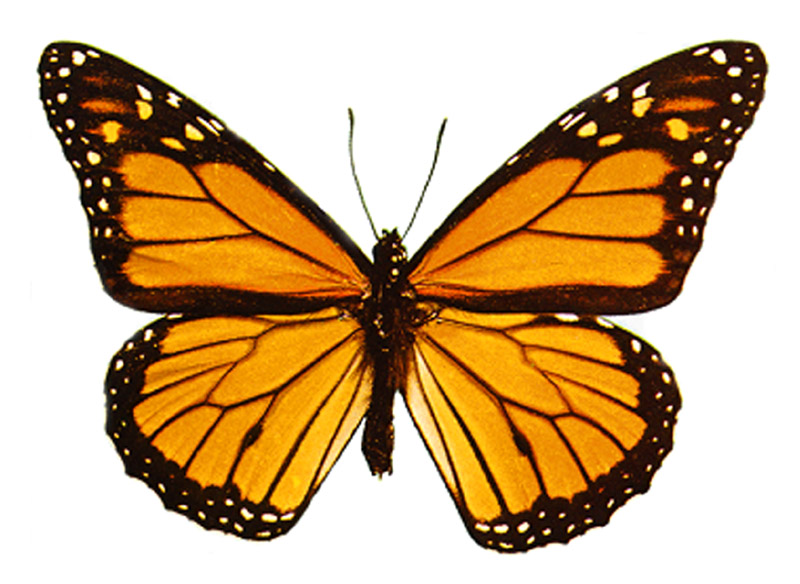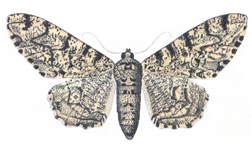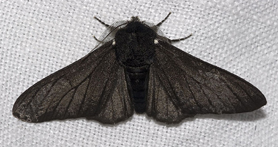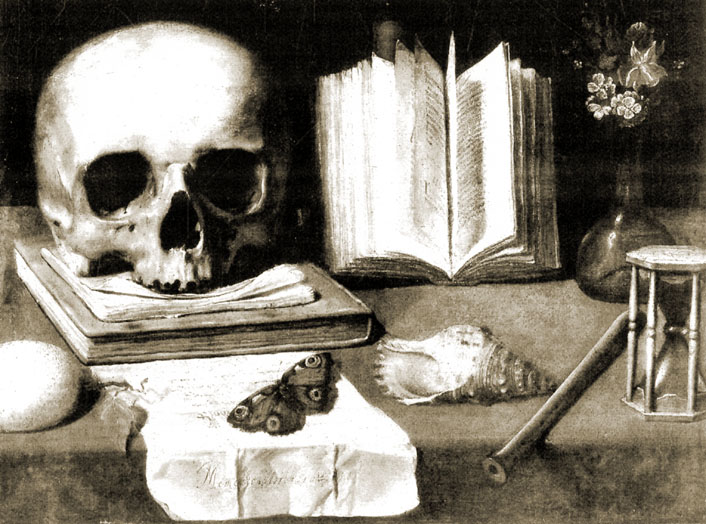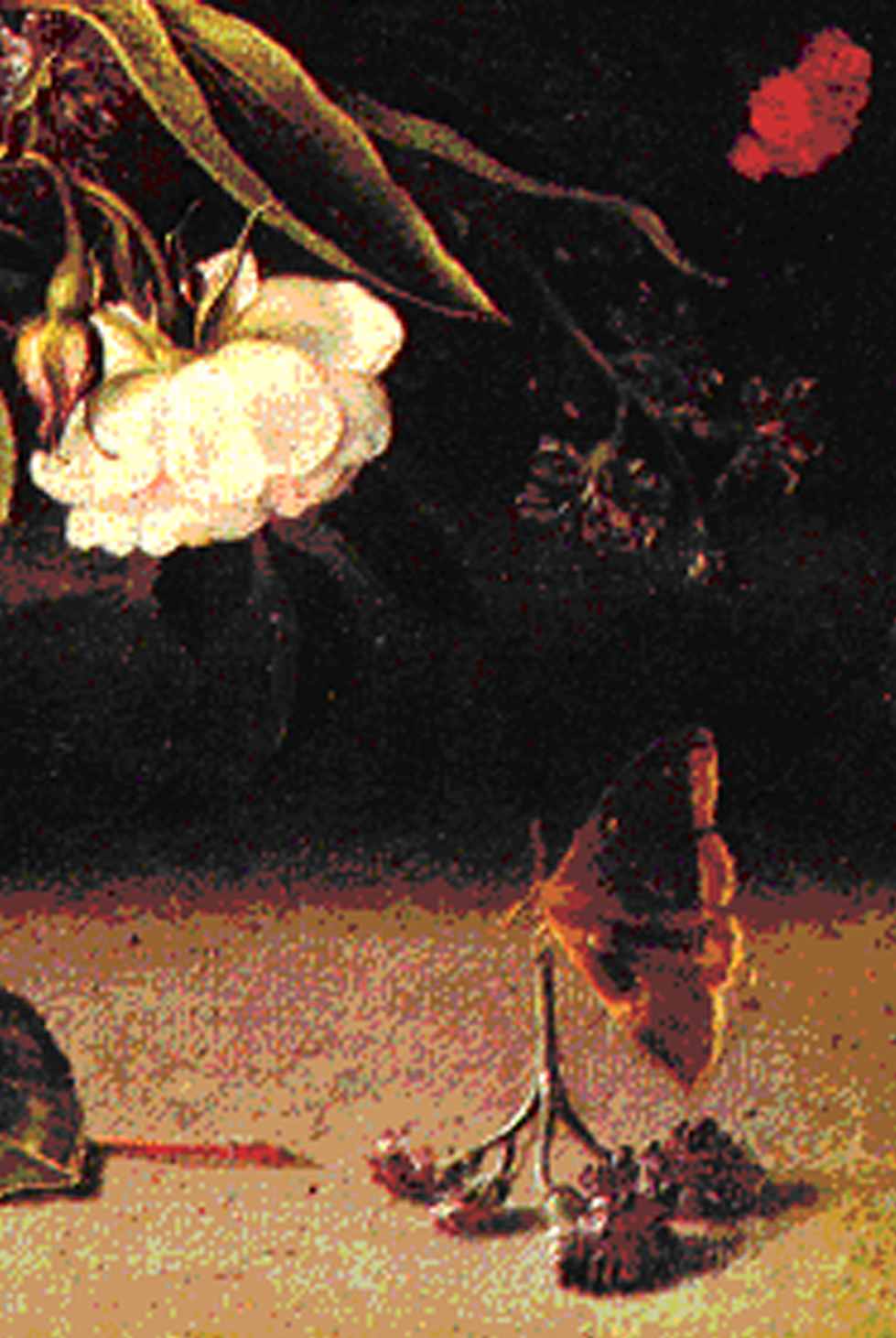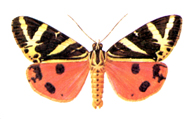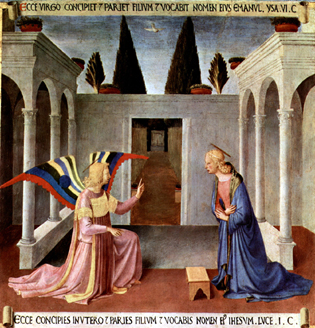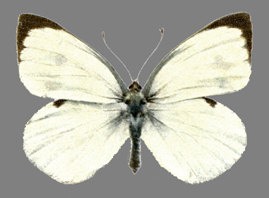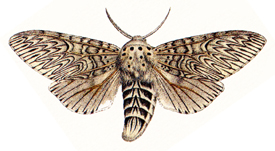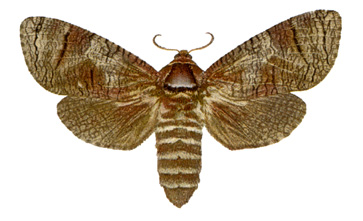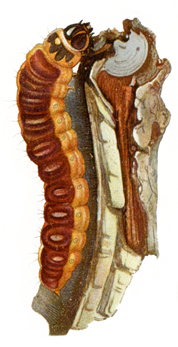Butterflies and Moths in Nabokov's Published Writings
Alphabetical Order ‒ Page 2
Babochka babochka Nab.: an imaginary butterfly with a rather satyrine outline drawn by Nabokov "For my best translator, Dmitri Nabokov from his father" in May 1963 and reproduced on the flyleaves of Selected Letters. Babochka is Russian for "butterfly". Tautonymy is admissible in zoology (it is not in botany), i.e., generic and specific name may be the same. So Babochka babochka means a butterfly named butterfly of the genus of butterflies, and as there is the male sign added, it is "Mr. Butterfly", so to speak. Between 1917 and 1922, Nabokov wrote a Russian poem entitled Babochka; in its subtitle, it said which one the author had in mind: »Nymphalis antiopa, the Camberwell Beauty.
*SelLet; Stikhi 60
Baltia butleri potanini Alphéraky, 1888 [Pieridae, Pierinae]: a subspecies of Butler's Pierid (Baltia butleri Moore, 1882), in Sikkim, Kashmir, Tibet, Karakorum, Mongolia. Staudinger's Catalog (1901) gives no locality for B. b. potanini and Nan-Shan, Amdo and WC China for B. butleri.
*Gift 121
& Ac: Báltia bútleri potaníni • Butler's Pierid • Ge: *Butlers Weißling • Ru: (Dar) бутлерова белянка
Baronia brevicornis (Wikipedia)
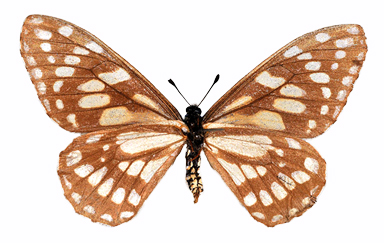
*Baronia brevicornis Salvin, 1893 [Papilionidae, Baroniinae]: in The Aurelian, there is "the short-clubbed beauty that a Mr. Baron had just discovered in Mexico". This is a reference to an actual discovery. Baronia brevicornis is a rare and strange papilionid, occurring solely in some parts of S Mexico where the types were collected by the German naturalist O.T. »Baron. Salvin published the OD in the Transactions of the Entomological Society of London, 4, 1893, p. 331. The wingspan is 48 mm in the males and 60 mm in the females; the coloring is brown with inset yellow. As the name brevicornis implies, it has two short 'horns,' or antennae. It has a genus (Baronia) and a subfamily (Baroniinae) all to itself and is considered one of the primitive papilionids. Though lacking tails, it is closer to the swallowtails than to the parnassians.
*Stor:Aur 254
Basilarchia Scudder, 1872: an American genus of Nymphalidae, subfamily Limenitidinae (admirals). The type-species is Basilarcha astyanax Fabricius, 1775, the Red-spotted Purple.
|
The model: Danaus plexippus (Staněk 1977) |
The mimic: Basilarchia archippus (Weed 1925) |
|
|
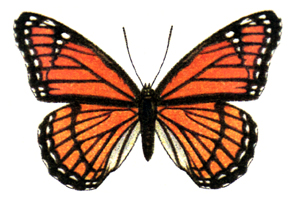
|
Basilarchia (ex Limenitis) archippus Cramer, 1776 [Nymphalidae, Limenitidinae]: an American admiral with a wingspan of 67–76 mm, russet-orange with black veins above and below and white-spotted black margins, flying from S Canada to Florida and westwards to SE California, in riverbeds, wet meadows, gallery forests and marshes, wherever its favorite foodplants (willow, poplar and aspen) occur.
The Viceroy presents a case of true mimicry. It mimics the Monarch (»Danaus plexippus), which is not a limenitidine but a danaine nymphalid, almost to the point of perfection. "The Viceroy mimicks the Monarch not only in appearance but also in behavior …" (Nabokov). The mark that does distinguish it from its model is a black line running down across the fore- and hindwings. Also, it just reaches the size of the smaller Monarchs. Its distribution is from S Canada down to Mexico and the West Indies. In Ada it is called "one of the Monarch's best known imitators". Cf. also »Nymphalis danaus Nab.
*Ada 158; NabBut 398 (L); Lep16; Int1 130
& Ac: Basilárchia/Limenítis archíppus • Am: Viceroy, The Mimic • Fr: (Ada) le Sylvain Vice-Roi • Ge: *Viceroy
Basilarchia arthemis (Weed 1927)
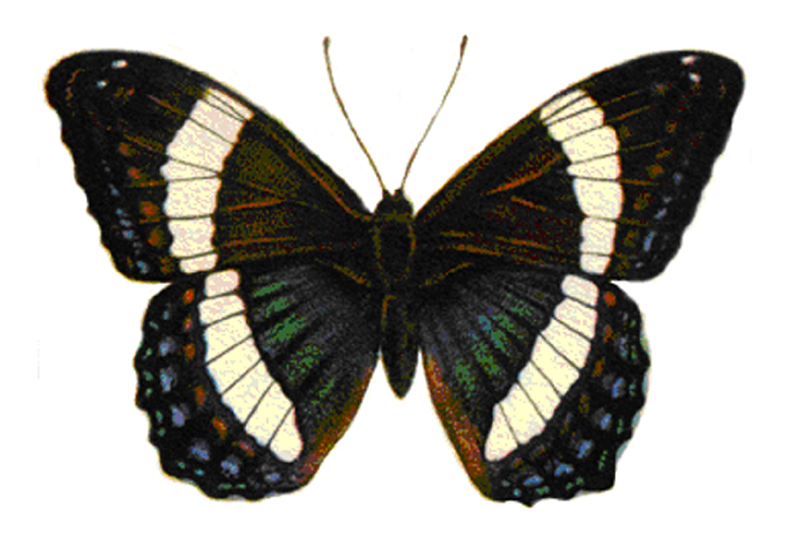
Basilarchia arthemis Drury, 1773 [Nymphalidae, Limenitidinae]: the White Admiral, from Alaska to British Columbia and from Manitoba and Minnesota to New York and Maine. It is predominantly black and white, with a blue and green lustre on the hindwings. The wingspan is 73–79 mm.
*NabBut 398 (L), 538–544; Boyd VNAY 365, 379, 385, 508
Bath White: »Pontia daplidice
belia: »Anthocaris belia
Bellargus: »Polyommatus bellargus
Bichroma (ex Fidonia) famula Esper, 1787 [Geometridae, Ennominae]: a geometer moth, in S Europe.
*Lep2 257
bird-wing butterfly: »Troides
|
Biston betularius f. typicus (Hübner 1793-1827) |
Biston betularius f. carbonarius (Wikipedia) |
|
|
|
*Biston (ex Amphidasis) betularius Linnaeus, 1758 [Geometridae, Ennominae]: this probably is the moth referred to twice in The Gift: "The four lovely gauze wings of the softest geometrid moth in the world spread flat on a mottled pale birchtrunk". Its wingspan is 45–50 mm and its habitat are the deciduous woodlands of Europe, temperate Asia and N America. Its delicate black-and-white pattern provides good camouflage especially on birch-trees where it spends the day pressed flat against the bark, flying only at night. It is also the most famous case of industrial melanism: a form of Biston betularius (the form betularius carbonarius Jordan, 1869 as opposed to betularius f. typicus) has rapidly adapted to sooty industrial smoke by turning from basically white to black (see in »Nabokov and Mimicry).
In the Italian translation (1991), this is Erannis defoliaria Clerck, 1759 [Geometridae], a moth whose wings are mottled a reddish yellow and less gauzelike than those of Biston betularius and whose caterpillar feeds mostly on oak and in orchards and has no special affinity to birch-trees. Also, Erannis defoliaria is one of the worst pests, its caterpillars being capable of defoliating whole forests – an unlikely object of affection. On a later page of the Gift, there is mention of "our favorite rarity," pressed flat against the bark of a birch-tree.
*Gift 24, 107
& Ac: Bíston betulárius (carbonária) • En: Peppered Moth, Pepper-and-salt Geometer • Fr: la phalène du bouleau • Ge: Birkenspanner • It: geòmetra della betulla • Ru: пяденица березовая • Sp: bistón del abedul
& Ac: Eránnis defoliária • Ge: Großer Frostspanner • Ru: пяденица-обдлоира
Black Apollo: »Parnassius
Black-veined White: »Aporia crataegi
blue: common name for a group of butterflies (but not a clearly delineated taxon) within the extensive family of »Lycaenidae. In the broadest sense this group consists of all lycaenids, including those that are not blue at all. In a narrower sense, blues are the members of the subfamily Polyommatinae, most of which really are blue. But even in many of the blue blues, it is only the males that are blue while the females often are partly or completely brown.
"When a lepidopterist uses 'Blues', a slangy but handy term, for a certain group of Lycaenids, he does not see that word in any color connection because he knows that the diagnostic undersides of their wings are not blue but dun, tan, grayish, etc., and that many Blues, especially in the female, are brown, not blue" (Nabokov in a letter to Alfred Appel, Jr., April 3, 1967 – SelLet 411).
According to Nabokov (Lep8 104), the term 'blue' is not congruent with the subfamily »Plebejinae, and "no systematic term or division can exist for the concept of 'Blues' …"
About one third of the blues that have been well studied have some – symbiotic or parasitic – relationship with certain species of ants. Usually ants react very aggresively towards all strangers in their nests. Some lycaenid caterpillars, however, have managed to get around that dislike by secreting a juice that pacifies the ants. In some cases the ants are so eager for it that they will even carry the caterpillar into their nests. Usually both sides profit from the relationship. The ants will have the juice which is not "intoxicating" but a kind of syrup, a concentrated solution of sugars. The caterpillars feed on debris and on ant larvae and enjoy the protection an ants' nest affords them. Some species could not survive without being tended by ants in their caterpillar stage (in the Holarctic region all the Maculinea species and a few others). The blue of The Gift (p. 110) whose caterpillar has "concluded a barbaric pact" with an ant-hill could be any of these species but is likely to be the most noted one, »Maculinea arion. The exotic one that "will not stoop to [this practice]" is Liphyra brassolis Westwood, 1864, a large lycaenid of the Indo-Australian region, from Sikkim and Assam across SE Asia to the Moluccas and Australia, with a wingspan of about 84 mm, amber wings with black margins and markings, called Moth Butterfly because of its moth-like appearance. Its caterpillar does not secret any syrup for the tree ants in whose nests it lives and on whose larvae it feeds. "When the butterfly emerges from the pupa, the wings and body are covered with highly adhesive scales, which will stick to any ants that may attack it" (Carter, 1992).
*Stor:Xmas 134; Glory 48; Gift 110; StrOps 323; Ada 128, 551, 552; SelLet 410–411; Lep8 104; Int16
& Fr: azurés, bleus • Ge: Bläulinge • It: licenidi • Ru: лазоревые голубянки
Boloria Moore, 1900: a genus of »Nymphalidae, subfamily Heliconiinae, tribe Argynnini (fritillaries). The type-species is »Boloria pales, the Shepherd's Fritillary.
*StrOps 323; SelLet 368
Boloria aquilonaris Stichel, 1908, syn arsilache Knoch, 1781 [Nymphalidae]: the Cranberry Fritillary, from France and Fennoscandia E to the Amur region.
There is a subspecies, Boloria aquilonaris alethea Hemming, 1934 sensu Leraut, 1980 whose name, according to Leraut (1997), should be Boloria aquilonaris ericeti Crosson du Cormier, 1959. In his notes for The Butterflies of Europe Nabokov reflected that if a name has to be replaced because it turned out to be preoccupied, the new name should be based on the name of the first author, or an anagram of it. As one of the examples he cites alethea. When alethea had to go, the replacement name should have been based on that of the author, Eugen »Esper, for instance esperi or seripe (anagram of Esper).
Nabokov refers to a taxon 'sifonica aquilonaris'. This is a reference to a C Asian butterfly, Boloria pales var. sifanica Grum-Grzhimaylo, 1891, described from Amdo (formerly NE Tibet). It is not clear whether Nabokov wanted to say that he considers aquilonaris to be a subspecies of sifanica, as the form of the citation might suggest. According to Higgins (1975), some authors consider Boloria sifanica a synonym of Boloria aquilonaris.
*NabBut 579 (BE), 602 (BE), 623 (L)
Boloria bellona toddi: »Clossiana bellona toddi
Boloria eunomia alticola: »Proclossiana eunomia alticola
Boloria euphrosyne: »Clossiana euphrosyne
Boloria freija: »Clossiana freija
Boloria frigga: »Clossiana frigga
Boloria frigga sagata: »Clossiana frigga sagata
Boloria graeca Staudinger, 1870 [Nymphalidae]: the Balkan Fritillary, in the SW Alps, Balkans and Greece.
*NabBut 601 (BE)
Boloria graeca balcanica Rebel, 1903 [Nymphalidae]: a subspecies of the Balkan Fritillary, described from the Rila Mountains, Bulgaria.
Nabokov, in his review of the Higgins & Riley field guide (Lep22): "I must disagree with the misapplication of the term 'f'. (meaning 'form'). It is properly used to denote recurrent aberrations, clinal blends, or seasonal aspects, but it has no taxonomic standing (and available names for such forms should be quote-marked and anonymous). This the authors know as well as I do, yet for some reason they use 'f.' here and there as a catchall for altitudinal races and minor subspecies. Particularly odd is 'Boloria graeca balcanica f. tendensis,' which is actually Boloria graeca tendensis Higgins, a lovely and unexpected subspecies for the sake of which I once visited Limone Piemonte where I found it at about 7000 ft. in the company of its two congeners, the Shepherd's and the Mountain Fritillaries." Leraut (1980) lists tendensis Higgins, 1930 as a mere synonym of balcanica, making the correct name of the butterfly Boloria graeca balcanica Rebel 1903. In the second edition of his marvelously comprehensive list (1997), there is Boloria graeca tendensis again. Further editions of the Higgins & Riley field guide listed tendensis as a subspecies of Boloria graeca without deciding whether it is a synonym of balcanica, while the successor volume (by Tolman & Lewington, 1997) has Boloria graeca f. tendensis in the SW Alps and Boloria graeca f. balcanica in Bosnia-Herzegovina. The definite word on this butterfly does not seem to be in yet.
*StrOps 333
Boloria graeca tendensis HIGGINS, 1930: In June, 1967, Nabokov spent nearly four weeks at its type-locality to hunt for this alleged subspecies, Limone Piemonte and the Col de Tende, "and climbing at 7,000 feet found 'all that he had dreamed of'" (Boyd, VNAY, p. 525). The Musée cantonal de Lausanne preserves 13 of his captures. Cf. »Boloria graeca balcanica.
Boloria kriemhild: »Clossiana kriemhild
Boloria (ex Argynnis) napaea Hoffmannsegg, 1804 [Nymphalidae]: a local fritillary in the E Pyrenees, C Alps (from 1,500–2,500 m), Fennoscandia, Altai, Alaska, Wyoming.
*StrOps 333; NabBut 580 (BE), 623 (L)
& Ac: Bolória/Argýnnis napáea • Am: Napeae Fritillary, Mountain Fritillary • Fr: le nacré des renouées • Ru: перламутровка Напея
Boloria pales Denis & Schiffermüller, 1775 [Nymphalidae]: an alpine fritillary with a wingspan of 30–37 mm, flying in isolated colonies in the Pyrenees, Alps, Carpathian Mountains, Caucasus, above timberline, up to 3,000 m.
There is a subspecies Boloria pales pyrenesmiscens Verity, 1932 in the Cantabrian Mountains and the Pyrenees, between 1,500–2,100 m.
The subspecific names Boloria pales mixta Warren, 1944 described from the Hautes Alpes in France and Bolores pales mixta Verity, 1950 are synonyms of each other and moreover seem to have been synonymized under pales, so both names are extinct.
*StrOps 333; NabBut 601 (BE), 623 (L); LtVé 97
& Ac: Bolória páles • En: Shepherd's Fritillary • Fr: le nacré subalpin • Ge: Hochgebirgs-Perlmutterfalter • Sp: perlada alpina
Boloria rossica grandis: »Clossiana titania grandis
Boloria rossica ingens: »Clossiana titania ingens
Boloria selene: »Clossiana selene
Boloria selene: »Clossiana selene albequina
Boloria selene: »Clossiana selene tollandensis
Boloria sifanica: »Boloria aquilonaris
Boloria titania: »Clossiana titania
Boloria titania helena: »Clossiana titania helena
Boloria toddi: »Clossiana bellona toddi
Bombycidae Hampson, 1892: a family of furry and stout moths of medium or large size, comprising around 300 species, most of them in tropical and subtropical Africa, Asia and America. The larvae feed on leaves and spin cocoons. Their name derives from the Greek word bombyx, silkworm. Their best-known representative is the Silkworm Moth proper, »Bombyx mori.
& Ac: Bombýcidae • En: silkworm moths • Fr: bombycidés • Ge: Seidenspinner • It: bombici • Ru: настоящие шелкопряды • Sp: bombícidos
Bombyx mori and its silkworm (Meyers Großes Konversations-Lexikon, vol.14, 1895-1890)
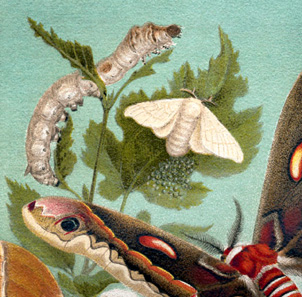
Bombyx mori Linnaeus, 1758 [Bombycidae]: This is the insect whose larva/caterpillar is cultivated to produce silk. It has been domesticated up to 5,000 years ago and does not occur in the wild. The whitish moth has wingspan of 3 to 5 cm but cannot fly. The females are bulkier because they carry so many eggs. These hatch after two weeks; the larvae grow to 6 to 7 cm in length and 15 mm in diameter and molt four times, eating voraciously. Their preference is for (white) mulberry leaves. For protection during the practically immobile winter months, they spin a cocoon of raw silk, consisting of a single thread of up to 900 metres. If they are not boiled to harvest the silk, they destroy it themselves by enzymes when spring comes. The Silkmoth is endemic in N India, N China, Korea, Japan and Taiwan.
The picture comes from a German encyclopaedia, late 19th century. In the lower part, it shows another and much bigger silkmoth (wingspan up to 16 cm) quite similar to »Attacus atlas. It is the South American Silkmoth Hyalophora cecropa linnaeus, 1758. The snake-like appearance of the forewing borders is quite obvious. Its purpose is to scare away predators.
*Stor:Aur 247; Lol 259
& Ac: Bómbyx móri • En: Silkworm Moth, Mulberry Moth • Fr: le bombyx du mûrier • Ge: Seidenspinner, Maulbeerspinner • It: bòmbice da seta • Ru: шелкопряд тутовый • Sp: bómbice setífero, baco de seta
Bonus bonus: »Flammea palida
Caligo eurilochus, underside (© DEZ 2011)
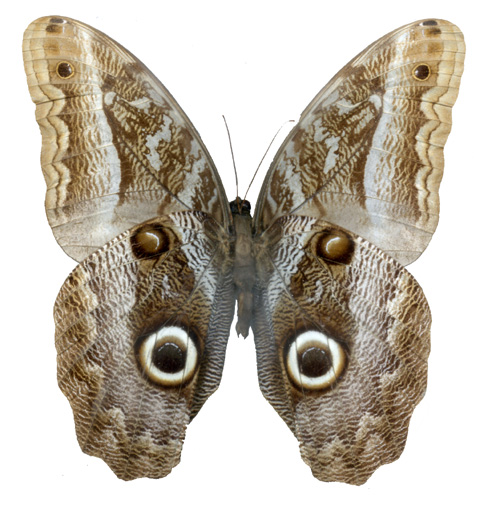
Brassolini Boisduval, 1836: a small tribe in the nymphalid subfamily Morphinae, comprising about 80 species and found only in the tropical rain forests of C and S America. The brassolini are large to very large, especially those of the genus Caligo Hübner, 1819 that has wingspans up to 200 mm; the type-species is Caligo eurilochus CRAMER, 1775. They fly mostly at dusk and dawn. Some feed on banana plantations and are considered pests. The big ringed eyespots on the underside of hindwings they show when resting, together with the feather-like, brownish gray pattern surrounding it, make them look uncannily like an owl's face. For this reason the whole family is called 'Owls'. The taxonomic position of the Owls is not quite certain yet. Some authors used to consider them a family of their own (Brassolidae Boisduval, 1836), on a par and somewhere between the 'Satyridae' and the 'Morphidae' to whom they seem quite close.
& Ac: Brassolín • En: Owl Butterflies
Twice, in Speak, Memory and in his Lectures on Literature, Nabokov mentioned a remarkable case of mimicry (in a more general sense): "Consider the imitation of oozing poison by bubblelike macules on a wing …" And more explicit still: "There is a species of butterfly on the hindwing of which a large eyespot imitates a drop of liquid with such uncanny perfection that a line which crosses the wing is slightly displaced at the exact stretch where it passes through – or better say under – the spot." The idea comes from Yosif »Portschinsky. It is not clear which species of butterflies Nabokov was referring to. There are many butterflies and moths whose eyespots look like drops of liquid, though without the refraction phenomenon Nabokov mentions. The bubble reminiscence is especially marked in some of the larger Owls. It is unlikely, however, that these pseudo-bubbles really are meant to give an impression of oozing poison. The trick would work only in a habitat where a drops regularly signals "poison" to potential predators. Under most circumstances, they would only signal "water" or "a rain has passed," especially so in the rain forest where the Owls fly at dusk. There is at least one species with something like the refraction phenomenon mentioned, the huge Caligo eurilochus Cramer, 1775 (the type-species of Caligo) in Mexico, C America and the Amazon basin. But here the slightly broken lines (actually some of the wing's veins) cross the Owl's eyespots and not the smaller and more bubble-like macules above them. (Cf. also »Cerura vinula.)
*SpeakM 124; LecLit 374
Brenthis Hübner, 1819: a genus of »Nymphalidae, subfamily Heliconiinae, tribe Argynnini (fritillaries). The type-species is »Brenthis hecate DENIS & SCHIFFERMÜLLER, 1775, the Twinspot Fritillary.
& Ru: (DarII) брентнд
*NabBut 207 (FB), 448 (L); LtVé 89
Brenthis daphne Denis & Schiffermüller, 1775 [Nymphalidae]: the Marbled Fritillary, in S Europe, NE Turkey, Middle East, S Urals, NW Kazakhstan, S Siberia, Mongolia, China, Japan.
*NabBut 601 (BE)
Brenthis dia: »Clossiana dia
Brenthis hecate (Lampert 1907)
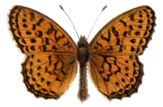
Brenthis hecate Denis & SCHIFFERMÜLLER, 1775 [Nymphalidae]: a fritillary occurring locally in S and SW Europe, from the Balkans across Asia Minor and S Russia to C Asia.
*StrOps 331; SelLet 473
& Ac: Brénthis hécate • En: Twinspot Fritillary • Fr: l'agavé • Ge: Saumfleck-Perlmutterfalter • Ru: перламутровка Хекате • Sp: hechicera
Brephidium Scudder, 1852: a genus of small »Lycaenidae, Polyommatinae (blues), tribe Polyommatini, Brephidium Section. The members of this genus are colloquially called Pygmy Blues or Dwarf Blues. There are two species in N and C America, one in Africa. The type-species is »Brephidium exile. In his technical paper on Klots' field guide (Lep19) Nabokov remarked that Brephidium is uncorrectly placed between Hemiargus and Lycaeides, two blues of what Nabokov called the subfamily »Plebejinae and what was to be the »Polyommatus Section. "Brephidium, of course, stands on the very outskirts of the family [of Lycaenidae], in a highly specialized group, immeasurably further removed from Hemiargus or Lycaeides [i.e., the Polyommatus Section] than, say, Lycaena [i.e., the Coppers] … Views may differ in regard to the hierarchic element in the classification I adopt, but no one has questioned so far the fact of the structural relationship and phylogenetic circumstances I mean to reflect".
*StrOps 319–20; NabBut 445; Lep9 44
Brephidium exile Boisduval, 1852 [Lycaenidae]: the Western Pygmy Blue (wingspan 10–19 mm), in the lowland (washes, marshes, railroad tracks, vacant lots) from Oregon and California east to Great Basin and Nebraska and south to Texas and S America.
Brephidium isophthalma Herrich-Schäffer, 1862 [Lycaenidae]: the Eastern Pygmy Blue (wingspan 13–19 mm), an Antillean species also found on salt marshes and tidal flats in SE United States (coastal Alabama, Georgia and Florida).
In his important paper on S American blues (Lep9, 1945), Nabokov listed the twenty-four genera comprising the »Plebejinae (today's »Polyommatus Section. Genus no. 11 has the entry: "Freyeria Courvoisier: t[ype-species] trochilus; 2 [species in the genus]; PT [= Palaeotropical] one reaching P [= Palearctic], the other reaching AU [= Australia]". The second species has this footnote: "The correct name of which is Freyeria putli Kollar – granted of course that »Chilades putli Moore and »Chilades trochilus isophtalma Waterhouse (nec Herrich-Schaffer) which I have dissected are the same as Lycaena putli Kollar from North India whence I have no material."
It is unclear what "Chilades trochilus isophtalma Waterhouse" is supposed to be. Both »Chilades (ex Freyeria) trochylus and Brephidum isophthalma are polyommatines, both are small and both bear a certain superficial resemblance. But the Palearctic and African genus »Chilades belongs to the »Polyommatus Section while the American genus »Brephidium belongs on the outskirts of the Lycaenidae, as Nabokov emphasized. Both are "unmeasurably" far removed from each other, and there is no way of making a species of one a subspecies of the other. Perhaps this is what Waterhouse who named the specimen had done. The other possibility is that Waterhouse had used Herrich-Schäffer's established name 'isophthalma' a second time, with a changed spelling, as 'isophtalma'. Legally it would have been feasible, but awkward and confusing all the same. The specimen Nabokov examined must have been a Chilades and not a Brephidium, otherwise he would have discarded it from his material. On the other hand, Chilades putli Kollar, 1844 from N India according to Bálint & Johnson (1997) seems to be a good species.
*Lep9 47
Brimstone: »Gonepteryx rhamni
Brintesia Fruhstorfer, 1911: a genus of »Nymphalidae, subfamily Satyrinae, tribe Satyrini. The type-species is »Brintesia circe, the Great Banded Grayling, in S and E Europe, Turkey, Middle East to Himalayas.
*NabBut 580 (BE)
The Great Banded Grayling, Brintesia circe (Lampert 1907)
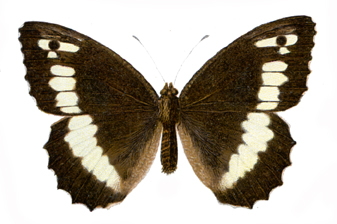
Brintesia (ex Kanetisa, Satyrus) circe Fabricius, 1775 [Nymphalidae, Satyrinae]: a large black and white satyrine (wingspan 60–70 mm), in C and S Europe, Turkey, Middle East to Himalayas. "A lazy and clumsy flier, haunting hayfields and oak groves …"
*NabBut 589 (BE); Lep1 32; Lep2 270
& Ac: Brintésia/Kanetísa círce • En: Great Banded Grayling • Fr: le silène • Ge: Weißer Waldportier • It: sileno, satiro circe • Ru: сатир Цирцеа • Sp: rey mozo
Broad-tailed Hummingbird: this must be one of the hawk moths [Sphingidae] hovering like hummingbirds, but it is impossible to say which. Hummingbird hawk moths with especially broad tail ends are Hemaris tityus, Hemaris fuciformis or (the most likely candidate) the Hummingbird Hawk Moth proper, »Macroglossum stellatarum.
*StrOps 317
& Ac: Macroglóssum stellatárum • Fr: le moro-sphinx • Ge: Taubenschwänzchen *Breitschwänziger Schwärmer • It: passera dei morti • Ru: языкан мареновый • Sp: esfinge colibrí, esfinge moro
& Ac: Hémaris títyus • Fr: le sphinx-bourdon • Ge: Skabiosenschwärmer • Ru: бражник Титий • Sp: esfinge de la madreselva
& Ac: Hémaris fucifórmis: Fr: le sphinx-gazé • Ge: Hummelschwärmer • Ru: бражник трутневидный • Sp: esfinge hemorrágica
Brown Hairstreak: »Thecla betulae
Bryony White: »Pieris bryoniae
burnet moth: any member of the family »Zygaenidae, subfamily Zygaeninae
Butler's Pierid: »Baltia butleri
Butterflies in Art: In the mid-1960s, Nabokov collected material for two butterfly book projects he pursued and none of which was realized. One was his The Butterflies in Europe project, a richly illustrated catalogue of all European Rhopalocera with their valid subspecies. The copious notes for it and the letters concerning it were published by Boyd & Pyle in Nabokov's Butterflies (2000), p. 569-625. Nabokov wanted ample and excellent color plates, and in September, 1965 the publisher (George Weidenfeld) explained that the reproduction costs and the travel expenses involved would be forbidding.
The other project went under the working title Butterflies in Art and was first proposed to a New York publisher (Oscar de Liso) in 1964: "... he would indeed be interested in compiling a book on Butterflies in Art, a subject that had interested him for many years. Even in 1949 he had spoken of it as something he had long wanted to write about, perhaps ever since he had determined the country of origin of a painting by identifying the local form of butterfly it depicted. Since butterflies evolve into new subspecies and species at a prodigious rate, the problems such a study could resolve, Nabokov mused, might include these: 'Were certain species as common in ancient times as they are today? Can the minutiae of evolutionary change be discerned in the pattern of a five-hundred-year-old wing?' He would go back as far as the butterflies of ancient Egypt, painted on the walls of Theben tombs [see »Danaus chrysippus], and as far forward as seventeenth-century Dutch still lifes. Over the next few years the project would take him around many pinacothecas, large and small, throughout Italy, and although the work would never see publication, it would at least help stock the lavish picture-galleries of Ada" (Boyd, VNAY, p. 481-482).
With this book in mind, Nabokov in the following years inspected a number of galleries in Florence, Rome, Naples, Venice and Parma and others. Of the progress of this work we know only from occasional mentions in his letters or interviews, as when he pointed out that he had identified the butterflies in Bosch's "Garden of Delights" (»Aglais urticae, »Maniola jurtina). In an interview he said he had collected twenty atalantas for his Butterflies in Art project [»Vanessa atalanta]. He also mentioned four more painters who had figured butterflies: Jan Brueghel (1568-1625), Albrecht Dürer (1471-1528), Paolo Porpora (1617-1673) and Daniel Seghers (1590-1661). According to Dmitri Nabokov's memoir (On Revisiting Father's Room), the Brueghel painting foremost in Nabokov's mind was one where he had discovered the Red Admiral hidden in a bush. In Dürer’s "L'adorazione dei Magi" (1504), there are two hardly recognizable small folded butterflies on the left (Florence, Uffizii). The Seghers painting may have been "Vase with Flowers", c. 1637 (Bamberg), with a satyrine in the upper left corner. Porpora painted many insects and reptiles; Nabokov may have thought of his painting "Provence Roses, Shells, Turtle and Butterfly in a Landscape", prominently featuring an »Emperor Moth. On one occasion Nabokov mentioned there was a Scarce Swallowtail (he said "Zebra Swallowtail") in a painting by Gentile da Fabiano (»Iphiclides podalirius). We don't know how extensively he searched Dutch and Flemish still lifes. There are many where butterflies figure more prominently than in Brueghel the Elder or Seghers. Foremost are Ambrosius Bosschaert the Elder [»Vanessa atalanta], Jan van Huysum [»Lasiommata megera, »Pieris mannii], Abraham Mignon [»Inachis io], Rachel Ruysch [»Pieris brassicae], Adriaen van Utrecht and especially Otto Marseus van Schrieck [»Aglia tau, »Inachis io] whose main actors were reptiles and butterflies.
Nabokov must have taken many notes for this project. As Dmitri Nabokov remembered, "There are boxes of notes, too, for the butterflies-in-painting book" ("On Revisiting Father's Room", Encounter, Oct 1979, p. 78). However, just one of his index cards has been published, in Nabokov's Butterflies (p. 640). It reads:
Linard, Jacques c. 1600-45
Basket with Flowers. Louvre Mus.
An interesting pyri? in r. lower corner
quercus?
check
That is, Nabokov believed he had found an interesting Pear Peacock or an Oak Eggar in the right lower corner of a painting by Jacques Linard (1597–1645), a Corbeille de fleurs (c. 1627) in the Paris Louvre, and that he wanted to check what it was. It is not clear whether Nabokov had actually seen this painting or knew it only from reproductions or from hearsay. The resting moth in the lower right hand corner is indeed hard to make out, especially in reproductions. An inspection of the original showed that it very probably is a male Oak Eggar [»Lasiocampa quercus]. The size, the color and especially the two small spots on the forewings instead of the four large eye-spots of »Saturnia pyri all point to it. If he had actually seen it, Nabokov would not have been in doubt for a second. That he planned to check it indicates that he may only have heard that there was a Linard painting with pyri, one he had never seen. This is Vanité au papillon (1734), a Memento mori where Saturnia pyri figures prominently in the central foreground. Nabokov would not have liked the symbolic intention that had brought the big moth there (it stands for the departing soul) but perhaps he would have enjoyed the execution, and had he known it he would without any doubts have included it in his book.
|
Jacques Linard: "Vanité au papillon" (left) and "Corbeille de fleurs" (detail), Musée du Louvre. The moth in the left painting certainly is a Pear Peacock (Saturnia pyri). The moth in the lower right hand corner of the "Flower Basket" could very well be an Oak Eggar. (From Philippe Nusbaumer: Jacques Linard 1597-1645 - Catalogue de l'œuvre peint. Le Pecq-sur-Seine: Nusbaumer, 2006) |
|
|
|
|
As Dmitri Nabokov remembered (On Revisiting Father's Room, 1979), there was a reproduction of Fra Angelico's (c.1387-1455) Annunciation propped up on Nabokov's writing lectern, with his handwritten note, "referring to the angel's stylized rainbow wings: 'A recollection of Iphiclides podalirius with a slight dash of Papilio machaon and perhaps a hint of the day-flying moth Panaxia (= »Euplagia) quadripunctaria. The two blackish stripes of each 'wing' correspond to the pattern of I. podalirius in the natural position of rest *See Portman, Animal Forms, p. 110, NY 1967."
|
Fra Angelico: L'Annunziazione (c.1450), panel on a Silver Chest, San Marco Museum, Florence (Wikimedia.org) |
The Scarce Swallowtail (Iphiclides podalirius) (Lampert 1907)
The Jersey Tiger Moth (Euplagia quadripunctaria) (Lampert 1907)
|
|
|
butterfly orchid: there are several butterfly orchids, so it is not clear which Latin name the author of Ada withheld from the reader. It could be the European butterfly orchid Platanthera bifolia or the Moth Orchid Phalaenopsis amabilis of SE Asia and N Australia. The most likely candidate, however, is Psychopsis (ex Oncidium) papilio, the Butterfly Orchid proper, growing in subtropical and tropical America, from Costa Rica and Trinidad to Peru, with a solitary leaf, 15 to 22 cm long and rigidly erect, dull green mottled with purplish crimson. 'Orchid' comes from Greek 'orchis,' testicle; the orchids owe their name to the shape of their roots.
Cabbage White, 'cabbage,' cabbage butterfly: according to the OED, the name is colloquially and very broadly applied to all members of the genus »Pieris Schrank, 1801 in the family »Pieridae, subfamily Pierinae. In a narrower sense, it applies to just two species: »Pieris brassicae (the Large [Cabbage] White) and »Pieris rapae (the Small [Cabbage] White). Both are originally Palearctic, but with
|
The European Large Cabbage White, Pieris brassicae (Lampert 1907) |
The European Small Cabbage White, Pieris rapae (Lampert 1907) |
|
|
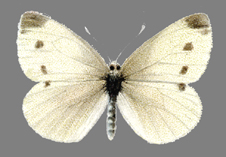 |
modern trade of vegetables, at least the Small White – which may well be the commonest of all butterflies – has spread to America, Australia and elsewhere. Both fly even in cities and have profited from agriculture; in Europe, they range as far north as the 62nd parallel and as high up as 2,000 m.
In "Father's Butterflies", there is the remark that the Stagirite (= Aristotle, after the name of his home town, Stageira in N Greece), "although he could distinguish between a 'cabbage butterfly' and a geniol [гениол, moth] that flew flamewards (that, apparently, was the extent of Aristotle's lepidopterological erudition), understood less about this distinction than a child or a layman today". In his History of Animals (8.19), written c. 350 B.C., Aristotle described the life cycles of a cabbage butterfly: "The so-called psyche or butterfly is generated from caterpillars which grow on green leaves, chiefly leaves of the raphanus, which some call crambe or cabbage. At first it is less than a grain of millet; it then grows into a small grub; and in three days it is a tiny caterpillar. After this it grows on and on, and becomes quiescent and changes its shape, and is now called a chrysalis. The outer shell is hard, and the chrysalis moves if you touch it. It attaches itself by cobweb-like filaments, and is unfurnished with mouth or any other apparent organ. After a little while the outer covering bursts asunder, and out flies the winged creature that we call the psyche or butterfly." In the same book (8.27) there is a sentence about a moth: "There is another insect resembling the moth, called by some the 'pyraustes,' that flies about a lighted candle: this creature engenders a brood full of a fine down". Pyraustes was a mythical fly believed to be engendered in the brass furnaces of Cyprus.
*Mary 91; Gift 108, 133; Stor:Aur 250; SpeakM 127, 176; PaleF 184; Ada 128; StrOps 329; LHarl 35; SelLet 284; NabBut 220 (FB); Lep1 32; Lep2 256, 268
& En: Cabbage Whites • Ge: Kohlweißlinge • Ru: (DarII) капустный мотылёк
Cacoecimorpha (ex Tortrix) pronubana HÜBNER, 1799 [Tortricidae]: a Palearctic tortricid or leafroller moth.
*Lep2 268
Caleophrys sheridani Edw: »Callophrys sheridanii
Callerebia Butler, 1867: a genus of »Nymphalidae, subfamily Satyrinae, tribe Satyrini. The type-species is Callerebia scanda Kollar, 1844, the Pallid Argus, in NW India, Nepal, Kashmir, Sikkim, W Himalayas.
In the table of Horlarctic Erebia species Nabokov drafted for his Butterflies in Europe project, he probably listed the Callerebia group and the preceding one (the Chinese Atramentaria group) only to make the table of Palearctic Erebia species complete, for neither Erebia atramentaria nor any Callerebia species occur in Europe and would have figured in his book.
*NabBut 591 (BE)
Callicore hydaspes (D'Abrera 1984)
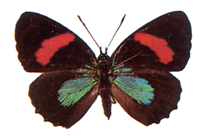
Callicore Hübner, 1819, syn Catagramma Boisduval, 1836: a S and C American genus of »Nymphalidae, subfamily Limenitidinae. The type-species is Callicore hydaspes Drury, 1782, in S Brazil and Paraguay. Callicore butterflies are of small to medium size and colorfully patterned, their areas and bands of few contrasting and unshaded primary colors giving them a modernistic design.
*StrOps 285
Callimorpha diminula (Hofmann 1894)
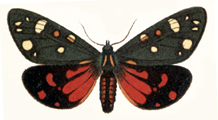
Callimorpha dominula Linnaeus, 1758 [Arctiidae, Arctiinae]: a variable European tiger moth with a furry, but sleek body, blackish with yellow and cream spots on the forewings and red with black spots on the hindwings. The wingspan is 45–55 mm. The range is temperate Europe eastwards to Caucasus. Its preferred habitat is moist forests and creek valleys.
There is no way of safely determining which lepidopteron Nabokov had in mind in his first poem with butterflies – "The Two" (1919) – because the details he gives are too scanty and because it is not clear whether all refer to the same insect. The cues are, "a furry lepidopteron he found near Pontresina, on a young aspen leaflet," "in spring," "ruby gleam" (of fire), "variegated". The furry body points to a tiger moth. With its four colors, Callimorpha dominula is 'variegated' and has red on the hindwings. It flies up to an altitude of 2,000 m (Pontresina in the canton Grisons is at 1805 m). One of the hostplants of this shy day- and night-flying moth is Populus; the European aspen is Populus tremula. It flies from May to late June, hence in spring. It may have caught Nabokov's fancy because it has the longest article in »Hofmann's butterfly atlas that he was thoroughly familiar with in his youth. The lengthy explanation was due to the fact that Maximilian Rudolph Standfuss (1854–1917), a Professor of Entomology at the Polytechnic Institute of Zurich had produced a hybrid by crossing Callimorpha dominula dominula and one of its many local varieties, persona Hübner, calling it var. romanovi Standfuss, 1892. Hofmann supposed that if dominula dominula and dominula persona became sympatric, romanovi would ensue naturally and be the prevailing form, and that this would be likely to happen in N and NC Italy.
& Ac: Callimórpha domínula • En: Scarlet Tiger • Fr: l'écaille rouge • Ge: Spanische Fahne, Schönbär • Ru: медведица-хозяюшка
Callimuchus dobrugensis: this is a conflation of two very similar blues from the shores of the Black Sea: (1) Tomares callimachus Eversmann, 1848 [Lycaenidae, Theclinae], in Anatolia, Iran, Iraq, Caucasus. (2) Tomares nogelii dobrogensis Caradja, 1895 [Lycaenidae], a subspecies of Nogel's Hairstreak, called after Dobrugea, local to Romania, Moldavia and the Ukraine.
*NabBut 212 (FB)
calliopsis: »Plebejus idas calliopis
Callipsyche behrii: »Satyrium behrii
Callophrys Billberg, 1820: a holarctic genus of small hairstreaks [Lycaenidae, Theclinae]. There are seven species and more subspecies in the W United States, all looking much alike. The uppersides are bright reddish brown, the undersides bright green.
*Int1 128
Callophrys avis (Chinery 1889)

Callophrys avis Chapman, 1909 [Lycaenidae]: a hairstreak very similar to the much more widespread »Callophrys rubi, but more brilliantly colored. What makes both of these hairstreaks distinctive are the green undersides of their wings, brown above. Chapman's Hairstreak flies in dry scrub containing Arbutus unedo in N Africa, isolated regions along the Mediterranean in S France and on the Iberian Peninsula, Asia Minor to Iran, usually below 700 m.
Nabokov named the incidental 'Avis Chapman' of Lolita after this green lycaenid.
*Lol 189; SpeakM 205; LolScrpl xii; StrOps 334; SelLet 414; NabBut 218 (FB), 610 (BE); Lep2 257
& Ac: Cállophrys ávis • En: Chapman's (Green) Hairstreak • Ge: *Chapmans (Grüner) Zipfelfalter • Ru: (DarII) авис • Sp: cejirrubia
Callophrys rubi Linnaeus, 1758 [Lycaenidae]: a very small Palearctic »hairstreak (wingspan c. 25 mm) distinguished by the brilliantly green underside of the wings; the upperside is brown. Callophrys rubi fervida Staudinger, 1901 is a subspecies in Morocco, the Iberian Peninsula and Asia Minor.
*Lep1 30; Lep2 256, 268, 269
& Ac: Cállophrys rúbi (férvida) • En: Green Hairstreak • Fr: l'argus vert • Ge: Brombeerzipfelfalter • Ru: (голубянка) малинная, малинница • Sp: cejialba
Callophrys sheridanii W.H. Edwards, 1877 [Lycaenidae]: a hairstreak of NW North America, from Canada to Arizona.
*N/WLet #69=58old
& Ac: Cállophrys sheridánii • Am: White-lined Green Hairstreak
Camberwell Beauty: »Nymphalis antiopa
Carcharodus Hübner, 1819: a genus of »Hesperiidae (skippers), subfamily Pyrginae (pyrgine skippers). The type-species is Carcharodus alceae, the Mallow Skipper.
*NabBut 577 (BE)
Carcharodus alceae Esper, 1780 [Hesperiidae]: a skipper of S and C Europe, Asia Minor, S and C Urals, W Kazakhstan, Turkestan, N Pakistan, N India, Altai, Tianshan.
*Lep1 29; Lep2 257, 268
& Ac: Carchárodus álceae • En: Mallow Skipper • Fr: l'hespérie de l'alcée • Ge: Malvenfalter • Fr: la grisette
Carcharodus althaeae: »Pyrgus malvae
Carcharodus flocciferus Zeller, 1847 [Hesperiidae]: the Tufted (Marbled) Skipper, in Morocco, Spain, S and SE Europe, E Turkey, S Urals, Transcaucasia, S Siberia, Kazakhstan, Altai.
*NabBut 577 (BE)
Carcharodus lavatherae Esper, 1763 [Hesperiidae]: a skipper, in N Africa, Europe S of 47°N, Turkey, S Urals, Transcaucasia. "I have often seen it in the Valais along footpaths in the vineyards between Varen and Susten".
*NabBut 577 (BE), 612 (BE); Lep1 29
& Ac: Carchárodus lavathérae • En: Marbled Skipper • Ge: Strauchpappeldickkopf • Fr: l'hespérie de l'épiaire
Carmen Tortoiseshell: »Nymphalis carmen
carpetiella: Nabokov's joke name for the Tapestry Moth Trichophaga tapetzella LINNAEUS, 1758 [Tineidae].
*LtVé 117
Carterocephalus palaemon (Lampert 1907)

Carterocephalus Lederer, 1852: a Holarctic genus of »Hesperiidae (skippers), subfamily Hesperiinae. The wingspan is 20–30 mm. Usually they are a chequered brown with yellow wing markings. The type-species is Carterocephalus palaemon Pallas, 1771, the Chequered Skipper, in C, N and E Europe, C and N Asia to Japan, and N America.
*NabBut 611 (BE); Lep3
Carterocephalus canopunctatus Nabokov, 1941 [Hesperiidae]: a skipper described by Nabokov. See in »Section 1.1.
*Lep3 222–223
Carterocephalus christophi Grum-Grzhimaylo, 1891 [Hesperiidae]: a skipper, in C Asia.
*Lep3 222
Carterocephalus demea: »Carterocephalus gemmatus
Carterocephalus dieckmanni Graeser, 1888 [Hesperiidae]: a skipper, in NE and S China, Amur and Ussuri regions, N Myanmar.
*Lep3 221–222
Carterocephalus flavomaculatus Oberthür, 1887 [Hesperiidae]: a skipper, in W China and Tibet.
*Lep3 222
Carterocephalus gemmatus Leech, 1891, syn demea Oberthür, 1891 [Hesperiidae]: a skipper in Tibet. According to Nabokov, Leech in 1891 had seen a proof copy of Oberthür's Carterocephalus demea and forestalled Oberthür by hastily describing the same species under his name, demea, a month before Oberthür's description was published. In 1897, Elwes and Edwards dismissed both demea and gemmatus as synonyms of Carterocephalus dieckmanni Graeser 1888. This, Nabokov argued after his examination of the group at the Museum of Natural History, had been premature: dieckmanni and gemmatus were clearly different species. So "little though Leech seems to have deserved it," Nabokov restored gemmatus.
*Lep3 221–222
Carterocephalus niveomaculetus Oberthür, 1887, var. tibetenus South [Hesperiidae]: a skipper in China and Amdo (formerly NE Tibet).
*Lep3 222
Carterocephalus (ex Pamphila) silvicolus Meigen, 1829, syn sylvius Knoch, 1781 [Hesperiidae]: a skipper of NE Europe, marked yellow and brown, with a wingspan of 23–29 mm.
*SpeakM 132
& Ac: Carterocéphalus/Pámphila silvícolus • En: Northern Checkered Skipper, (Nabokov) Silvius Skipper • Fr: l'hespérie de la crételle, (Autres rivages) une Hespérie • Ge: Schwarzfleckiger Golddickkopffalter, Golddickkopf, Waldmooswiesendickkopf
Catagramma-like insect: »Callicore
caterpillar (or larva): the second instar of a butterfly or moth, developing out of a fertilized egg and at the end of its phase changing into a pupa which in turn metamorphoses into the adult butterfly, called the imago. The main purpose of the caterpillar stage is to feed and hence to grow and gain weight. Nabokov has described the strains of metamorphosis from larva to pupa and from pupa to imago in an introductory remark to his lectures on Stevenson's Dr. Jekyll and Mr.Hyde and Kafka's Metamorphosis, published in 1999.
For the caterpillar resembling the root of Chinese rhubarb mentioned in Gift 123, see under »Hepialus armoricanus.
Catocala Schrank, 1802 [Noctuidae, Catocalinae]: a genus of relative large owlet moths usually having grayish or brownish forewings with a mottled camouflage pattern and striking hindwings with blackish bands on either red, blue or yellow, or a blue band on black hindwings. The type-species is Catocala nupta Linnaeus, 1767, the Red Underwing. The members of Catocala and a few related genera form the subfamily Catocalinae.
In his nostalgic poem about the joys of luring moths written in 1922, there comes "their empress, the bride of the breeze: / two ribbons of velvet on pink satin, / flamingo dust at the end of its abdomen". Though by no means certain, this might be one of the several underwings with two black bands on a red background. This rather shaky identification is reinforced by the fact that there are no other moths as explicitly 'feminine' as the underwings, with names like nupta, sponsa, electa, hymenaea, nymphaea, promissa, etc. Their red, however, is usually described as carmine or cinnebar. There is one with a much lighter red that also touches up the rings of its abdomen. It is Catocala pacta Linnaeus, 1758, obligingly flying in Germany, Poland and NE Europe. This seems to be the most likely candidate.
In Ada, there is the "flat larva of a local catocalid whose gray knobs and lilac plaques mimicked the knots and lichens of the twig to which it clung so closely as to practically lock with it". Most of the caterpillars of Catocala mimic the twigs on which they rest during day-time. However, there seems to be no one that exactly fits the description (gray knobs, lilac plaques, flat); but then many caterpillars change their appearance at each instar. Candidates are Catocala sponsa Linnaeus, 1767 and Catocala coniuncta Esper, 1787, both of them living on oak and therefore resembling a twig of that tree; or Catocala nupta Linnaeus, 1767, living on poplars and willows. Probably Ada's caterpillar is to render the camouflage idea of the whole genus.
*Gift 95; Ada 55; NabBut 107 (P)
& Ac: Catocalínae • En: underwings • Fr: (Ada) catocalides • Ge: Ordensbänder • Ru: ленточницы
& Ac: Catócala spónsa • En: Dark Crimson Underwing • Ge: Großer Eichenkarmin • Ru: орденская лента карминовая
& Ac: Catócala núpta • En: Red Underwing • Ge: Rotes Ordensband • Ru: орденская лента красная
Catocala adultera (Eckstein 1913)
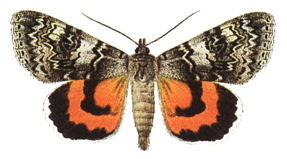
Catocala adultera Ménétriès, 1856 [Noctuidae]: the boy's exclamation ("'Catocala adultera!' I would triumphantly shriek") attests to considerable entomological sophistication. This underwing with red bands on its hindwings is a rather rare one, and it is very similar to the much more common Catocala nupta. Recognizing it at a glance is quite a feat.
*SpeakM 135
& Ac: Catócala adúltera • En: *Adultera Underwing • Ge: *Adultera-Ordensband • Ru: (Drugie berega) «катокала адултера»
Catocala fraxini (Seitz III)
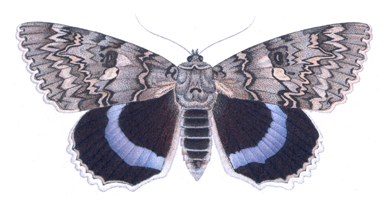
Catocala fraxini Linnaeus, 1758 [Noctuidae]: in The Gift, there is the jingle "Your blue stripe, Catocalid, shows from under its gray lid". It is likely that it refers to Catocala fraxini, a large underwing (wingspan up to 95 mm). It flies in the deciduous woodlands of N and C Europe across temperate Asia to Japan, also in N America. While the forewings have a grayish to brownish cryptic pattern, the dark brown hindwings have a striking blue band.
*Gift 95
& Ac: Catócala fráxini • En: (Clifden) Nonpareil • Am: Blue Underwing • Fr: la lichenée bleue • Ge: Blaues Ordensband, Escheneule • It: catocala del frassino • Ru: орденская лента голубая, (Nabokov) fraxini • Sp: noctuido de los fresnos
catocalid: any member of the genus »Catocala
Catochrysopinae (ex Lampidinae): an abandoned subfamily of »Lycaenidae, "containing the holotropical Leptotes Scudder and a huge array of palaeotropical species in several genera" (Lep9 3). The type-genus of the subfamily was Catochrysops Boisduval, 1832, with Catochrysops strabo Fabricius, 1793 (the Forget-me-not of SE Asia) as type-species. The Catochrysopinae have been fused with the subfamily Polyommatinae where they occopy the Catochrysops Section within the tribe Polyommatini.
*NabBut 302; Lep8 118, 120; Lep9 passim
Cattleya Hawk Moth : »Sphinx odetta
Celastrina Tutt, 1906: a genus of »Lycaenidae, subfamily Polyommatinae (blues), tribe Polyommatini, Lycaenopsis Section. The type-species is »Celastrina argiolus.
Celastrina (ex Lycaenopsis, Lycaena) argiolus Linnaeus, 1758 [Lycaenidae]: a Palearctic blue with a wingspan of 23–30 mm. Both males and females are pale lilac-blue, the males having very narrow black margins and the females very broad ones. It is found in parks and light forests all over Europe, N Africa and across temperate Asia to Japan. The closely related N American »Celastrina ladon used to be considered the same or as a subspecies of Celastrina argiolus.
The French version of Ada confirms that this is the butterfly Nabokov here had in mind. It has "la danse ailée d'un Argiolus d'Europe ou du lac de Echo en Californie."
*Ada 71; NabBut 607 (BE); Lep1 30; Lep2 256, 270
& Ac: Celastrína/Lycaenópsis/Lycáena argíolus • Am: Spring Azure • En: Holly Blue • Fr: l'argus à bandes noires, (Ada) l'Argiolus • Ge: Faulbaumbläuling • Ru: смородинная голчбянка • Sp: náyade
Celastrina ladon Cramer, 1780 [Lycaenidae]: the Spring (or Southern) Azure, a blue with nomenclatorial problems that has been described under more than ten different names and for a long time was considered to be conspecific with »Celastrina argiolus which is now considered a related but different European species. All over N America and NE Asia including Sakhalin, Korea and Japan.
Celastrina ladon echo W.H. Edwards, 1864 [Lycaenidae]: a W American subspecies of »Celastrina ladon, restricted to San Francisco by Brown & Clench in 1970. At the time of Ada's writing, it was still believed to fly all over the west coast, from British Columbia to Texas, except for the farmlands. Echo Lake that gave it its name is a small lake just S of Lake Tahoe. The French version of Ada revised by Nabokov confirms that Nabokov considered it the same as »Celastrina argiolus, the Holly Blue. It has "la danse ailée d'un Argiolus d'Europe ou du lac de Echo en Californie". In his copy of Ada Nabokov glossed 'Echo Azure' as 'pseudoargiolus' (Boyd, personal communication). This had been Boisduval's specific name (1833) for Celastrina ladon. It was in use far into the twentieth century but has been synonymized.
*Ada 71
& Ac: Celastrína ládon écho • Am: Echo Azure, Echo Blue, Southern Blue
Celerio Oken, 1815: an abandoned genus of »Sphingidae (hawk moths); its members today belong to the genus Hyles Hübner, 1819.
*Lep12
centaureae: »Pyrgus centaureae
Cercyonis behrii: »Cercyonis sthenele sthenele
Cercyonis Scudder, 1875: a genus of »Nymphalidae, subfamily Satyrinae, tribe Maniolini (US wood nymphs and satyrs, GB meadow browns and ringlets). The type-species is »Cercyonis pegala, the Common Wood Nymph.
Cercyonis pegala Fabricius, 1775 [Nymphalidae, Satyrinae]: the Common (or Large) Wood Nymph, the largest species of Cercyonis (wingspan 52–73 mm), with subspecies distributed throughout S Canada and the United States.
*NabBut 588 (BE)
Cercyonis pegala alope Fabricius, 1793 [Nymphalidae, Satyrinae]: the Blue-eyed Grayling, a subspecies of the Common Wood Nymph (»Cercyonis pegala), in the Atlantic States of N America.
*NabBut 398 (L)
Cercyonis pegala nephele Kirby, 1837 [Nymphalidae, Satyrinae]: a subspecies of the Common Wood Nymph (»Cercyonis pegala) possibly described from Ontario.
*NabBut 588 (BE)
Cercyonis pegala pegala Fabricius, 1775 [Nymphalidae, Satyrinae]: the nominal subspecies of the Common Wood Nymph (»Cercyonis pegala) restricted to the vicinity of Charleston, South Carolina.
*NabBut 588 (BE)
Cercyonis sthenele masoni Cross, 1937 [Nymphalidae, Satyrinae]: Mason's Satyr, in sagebrush-canyon country of Colorado, Utah, Arizona and Wyoming.
*NabBut 546 (L)
Cercyonis sthenele paulus W.H. Edwards, 1879 [Nymphalidae, Satyrinae]: the Little Satyr, in the Great Basin (Nevada, Utah, E California and Oregon).
*NabBut 546 (L)
Cercyonis sthenele sthenele Boisduval, 1852, syn behrii Grinnell, 1905 [Nymphalidae, Satyrinae]: the Woodland Satyr or Scrub Wood Nymph, from the Canadian border to Baja California and east to the Continental Divide. "I screamed when I got my first (specimen)." What Grinnell in 1905 described as Cercyonis behrii was a junior synonym of Cercyonis sthenele. The holotype was destroyed in the San Francisco earthquake of 1906.
*N/WLet #69=58old; NabBut 546 (L)
|
Cerura vinula (Sepp 1762) |
Caterpillar of Cerura vinula (Sepp 1762) |
|
|
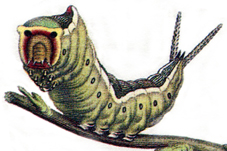 |
Cerura (ex Dicranura) vinula Linnaeus, 1758 [Notodontidae]: the Puss Moth, a large prominent moth (wingspan 45–70 mm) with a very plump body and mottled grayish wings, in moist biomes of the temperate zone of the Palearctic up to altitudes of 2,500 m. The rather ungainly Puss Moth develops from an interesting green caterpillar, often pictured because of its grotesque appearance in self-defense, raising the fore and the hind part, extending the peculiarly forked tail, bloating the thorax and, if persistently provoked, ejecting a jet of formic acid from its thoracic glands.
It is "a most uncaterpillarish caterpillar, with front segments shaped like bellows and a face resembling the lens of a folding camera. If you gently stroke its bloated smooth body, the sensation is quite silky and pleasant – until the irritated creature ungratefully squirts at you an acrid fluid from a slit in its throat" (Ada, p. 55).
In Speak, Memory (p. 124), the first case of mimicry (in the broad sense) Nabokov mentions is "the imitation of oozing poison by bubblelike macules on a wing (complete with pseudo-refraction) or by glossy yellow knobs on a chrysalis ('Don't eat me – I have already been squashed, sampled and rejected". The idea that the 'eyespots' (ocelli) of many butterflies and moths are not meant to look like eyes at all but like drops of a poisonous liquid comes from the Russian entomologist Yosif »Portschinsky. In a long-winded article (Horae Societatis Entomologicae Rossicae, vol. 27, 1893, p. 139–224) he explained that in his opinion the eyespots on the wings of butterflies and moths really are imitations of the eyespots found along the sides of some caterpillars which in turn originally were the marks of glands ejecting poison. The basic pattern, he says, is always the same though it does allow many variations: a black round spot surrounded by a red and a white ring of varying widths. The spot in the middle stands for a cavity opened to eject the noxious liquid. Portschinsky developed this theory from the larva of the Tau Emperor (»Aglia tau LINNAEUS, 1758, Saturniidae) which has several small ocellae (the adult moth has one beautiful large eyespot on each of its wings) but to the disadvantage of the theory does not eject any poison. So Portschinsky shifted the argument to the caterpillar of Cerura vinula which does squirt poison but unluckily lacks eyespots. To make up for them, Portschinsky argued that the caterpillar when attacked bloats the first reddish segment of its body collar-like and so does look like the ominous signal signifying "Attention, poison!" when seen from in front. "Contemplating the ocellae of the larvae of Aglia tau und Harpyia (= Cerura) vinula is so important to us because these have been transferred to the wings of various butterflies with astonishing exactitude …" – and Portschinsky goes on to describe the eyespots in a dozen mostly exotic species like the Paris Peacock of India, Myanmar and China (Papilio paris Linnaeus, 1758) or the female of the N American Spicebush Swallowtail (Papilio troilus Linnaeus, 1758) but also of the European Peacock Butterfly (»Inachis io) or the Red Admiral (»Vanessa atalanta). There is one variation on the theme, he explains. Instead of eyespots, the Jamaican Homerus Swallowtail (Papilio homerus Fabricius, 1793), for example, has clusters of many tiny dots along the margins of the hindwings. According to Portschinsky, they are meant to look like many tiny droplets of poison.
His theory about the origins of ocellae has not been refuted but completely disregarded and forgotten. While it is true that we don't know whether eyespots are actually meant to give the impression of staring eyes or whether humans only perceive them that way, it is generally assumed that they are what the name implies. As the behavioral biologist Wolfgang Wickler explains in his book on mimicry, there has been experimental proof that eyespots do scare birds. The larger the eyespots, the more effective they are, especially if suddenly deployed. Small eyespots on the other hand may attract birds to peck at them, and that may be their purpose. Usually they are placed along the margins of the wings, diverting the attack from more vital parts and giving the butterfly a chance to flee.
From what we know about the workings of evolution, Portschinsky's theory is plainly absurd. To avoid pecking at a dark spot ringed by red and white, a bird would have to associate unpleasant experiences with it. The more the allegedly deterring signal is exploited in nature without any noxious fluid to back it, the less effective it would be as a scare. There are no adult butterflies actually squirting poison. The threat would be an altogether empty one. A normally intelligent bird would learn soon enough that what to Portschinsky looks like a squirting gland usually is perfectly harmless and can be eaten without any ill consequences.
Still, at least to the human eye, some of those eyespots do look like drops of liquid, especially those with a kind of 3D effect, often due to a small white dot in the middle of the black center. They may still be meant to be eyes. Eyes too usually have a dark round spot in the center, surrounded by white and further rings of color, and they are watery.
The bubble-like appearance of the eyespots is particularly marked in some of the Owl Butterflies (»Brassolinae). These Nabokov may have had in mind when he wrote, "There is a species of butterfly on the hindwing of which a large eyespot imitates a drop of liquid with such uncanny perfection that a line which crosses the wing is slightly displaced at the exact stretch where it passes through – or better say under – the spot" (Lectures on Literature, p. 374). There is at least one species with something like the refraction phenomenon mentioned, the large Caligo eurilochus Cramer, 1775 (the type-species of Caligo), in Mexico, C America and the Amazon basin. Here the big eyespots on the hindwings are crossed by slightly broken lines, actually some of the wing's veins. However, the eyespots in Caligo are certainly meant to be eyes and not bubbles, for the whole surface of the wings is patterned and colored exactly like the feathers of a dark nocturnal bird of prey. So the whole dorsal side of the butterfly, with the large round eyespots surrounded by a dark brown and gray feather pattern, looks uncannily like an owl staring at you, and the predator who came to a different conclusion would be prey to the next real owl.
*SpeakM 124; Ada 55, 56; LecLit 374; SelLet 463
& Ac: Cerúra/Dicranúra vínula • En: Puss Moth • Fr: la queue fourchue, (Ada) la Dicranure, Queue Fourchue • Ge: Großer Gabelschwanz • It: cerura • Ru: хохлатка винная, большая гарпия • Sp: harpía
Chemerina caliginearia Rambur, 1833 [Geometridae, Ennominae]: a geometer moth, in SE Europe.
*Lep2 255, 256, 257
Chalceria heteronea Boisduval, 1852 [Lycaenidae, Lycaeninae]: the Blue Copper, from British Columbia, Idaho and Montana to S California, N Arizona and Colorado. "Males of this species are bright lilac-blue above, in sharp contrast to other species of this genus" (Howe 1975, p. 311).
*NabBut 605 (BE)
Chapman's Blue: »Polyommatus thersites
Chapman's Hairstreak: »Callophrys avis
Charaxes Ochsenheimer, 1816: a genus of Nymphalidae, subfamily Charaxinae. The type-species is Charaxes jasius Linnaeus, 1767, the Two-tailed Pasha.
*NabBut 575 (BE)
Charaxes verae Nabokov: an imaginary butterfly drawn for Nabokov's wife Véra on April 15, 1968 (their 43rd wedding anniversary) and reproduced on the flyleaves of Selected Letters. The specific name, verae, of course is the genitive of Véra. The generic name, however, is a real one. Charaxes Ochsenheimer, 1816 is a genus of Nymphalidae. The one drawn by Nabokov very much resembles the male of Charaxes jasius Linneaus, 1767, the only European butterfly to possess two tails on each of its hindwings. It is a large and pretty insect (with a wingspan of up to 100 mm in the female) flying along the Mediterranean coasts from Portugal to Turkey.
*SelLet
& Ac: Charáxes jásius • En: Two-tailed Pasha • Fr: le pacha à deux queues • Ge: Erdbeerbaumfalter • Sp: bajá
Charidryas Scudder, 1872: an exclusively N American genus of »Nymphalidae, subfamily Nymphalinae, tribe Melitaeini (checkerspots). The type-species is »Charidryas nycteis, the Silvery Checkerspot.
Charidryas damoetas Skinner, 1902 [Nymphalidae]: the Damoetas Checkerspot, in the mountains of Colorado, Wyoming and Utah.
*NabBut 524
Charidryas gorgone Hübner, 1810 [Nymphalidae]: the Gorgone Checkerspot, from Manitoba to Mexico and from the Carolinas and Georgia to the Rocky Mountains.
*NabBut 408 (L)
Charidryas (ex Melitaea) harrisii Scudder, 1865 [Nymphalidae]: Harris' Checkerspot, from Nova Scotia to Manitoba and southeast to West Virginia.
*NabBut 408 (L)
Charidryas harrisii hanhami Fletcher, 1904 [Nymphalidae]: Hanham's Crescentspot, a subspecies of Harris' Checkerspot described from Bird Hill, Manitoba. *NabBut 408 (L)
Charidryas nycteis Doubleday & Hewitson, 1847 [Nymphalidae]: the Silvery Checkerspot, from S Canada and the Great Plains to the Atlantic Coast.
*NabBut 408 (L)
Chazara (ex Satyrus) persephone Hübner, 1805, syn anthe Ochsenheimer, 1807 [Nymphalidae, Satyrinae, Satyrini]: the Rock Brown, in S Russia, Asia Minor, Afghanistan, Baluchistan, C Asia.
*Lep1 32
Chequered Blue: »Scolitantides orion
Chesias isabella Schawerda, 1915 [Geometridae, Larentiinae]: a geometer moth in SW Europe.
*Lep2 271
Chilades Moore, 1881: a genus of »Lycaenidae, subfamily Polyommatinae (blues), tribe Polyommatini, »Polyommatus Section. The type-species is Chilades cleotas Guérin-Ménéville, 1831, of New Guinea. In 1997, Chilades replaced the generic name Freyeria Courvoisier, 1920.
*Lep8 104; Lep9 passim, 47
Chilades (ex Luthrodes) cleotas Guérin-Ménéville, 1831 [Lycaenidae]: a blue of New Guinea. Nabokov: "… ranging from Malay to the New Hebrides, at least."
*Lep9 45
Chilades galba Lederer, 1855 [Lycaenidae]: the Persian Grass Blue, in Iran and parts of C Asia.
*Lep9 13, 45
Chilades phiala Grum-Grzhimaylo, 1890 [Lycaenidae]: a blue, in Near East and C Asia.
*Lep9 13
Chilades (ex Freyeria) putli Kollar, 1844 [Lycaenidae]: a blue of India and Sri Lanka.
*Lep9 8, 47
Chilades (ex Itylos, Lycaena) speciosa Staudinger, 1894 [Lycaenidae]: a synonym of Itylos titicaca (»Itylos).
*Lep8 104; Lep9 7
Chilades (ex Freyeria, Lycaena) trochylus Freyer, 1844 [Lycaenidae]: a brown 'blue,' that is a species of the subfamily Polyommatinae (where the males usually are blue) whose males are as brown as the females – and one of the smallest butterflies, with a wingspan of only 17–19 mm. Balkans, Asia Minor, Near East, tropical Asia and Africa.
*StrOps 333; Lep8 104; Lep9 8, 47 and passim
& Ac: Chiládes/Freyéria/Lycáena tróchylus • En: Grass Jewel • Fr: l'azuré de l'héliotrope, l'azuré de Freyer • Ge: *Heliotropbläuling
Chrysiridia riphearia (Procházka 1966)
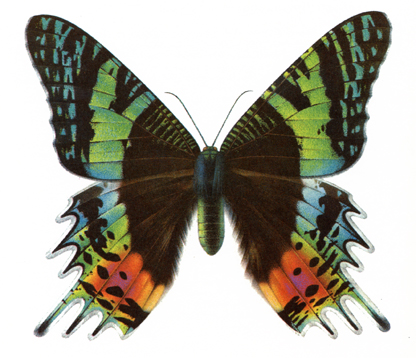
*Chrysiridia riphearia Hübner, 1823 [Uraniidae]: This very probably is the "iridiscent green insect with many tails" mentioned in The Aurelian. It is an unusual moth of "extravagant brilliancy" confined to Madagascar. Junior synonyms were Urania ripheus Godart, 1824 and Chrysiridia madagascariensis Lesson, 1831. According to David Carter, it is "often regarded as the most spectacular and distinctive of all moths. Its colors made it popular with the Victorians, who used its wings to make jewellery". Its wingspan is 80–100 mm. The hindwings have three longer and three short tails each, and the forewings are blackish with broken bright bands of a metallic green. For use in local Madagascan handicrafts, these showy moths today are raised in farms.
*Stor:Aur 251
& Ac: Chrysirídia/Uránia ripheária/riphéus/madgascarénsis • En: Madagascan Sunset Moth • Fr: la chrysiridia malgache
Chrysophanus dorilis: »Heodes tityrus
Chrysophanus gordius: »Thersamolycaena alciphron gordius
Chrysophanus phlaeas: »Lycaena phlaeas
Chrysophanus thersamon: »Thersamonia thersamon
Cinclidia (ex Melitaea) phoebe Denis & Schiffermüller, 1775 [Nymphalidae, Nymphalinae, Melitaeini]: a checkerspot (wingspan 32–42 mm) preferring warmer climates, from N Africa through C and S Europe to C Asia and N China. Of the alleged subspecies ('race') Melitaea phoebe minoa Fruhstorfer, 1916, Nabokov says ("Butterflies of Europe", 1964), "I am not sure this is a true subspecies which would not turn into the nominal form if bred at sea level". Since then, the name minoa has indeed been synonymized under phoebe.
*NabBut 598 (BE); Lep2 268
& Ac: Melitáea phóebe • En: Knapweed Fritillary • Fr: la mélitée des centaurées, le grand damier • Ge: Großer Scheckenfalter • Ru: шашечница Феба
Sesia apiformis (Lampert 1907)
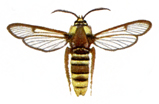
clearwing moths: the cosmopolitan family of »Sesiidae. They are small moths with glasslike wings that mimic wasps, bees, hornets, mosquitoes, flies and the like. The moth that "resembles a certain wasp" of Speak, Memory will be one of them, for example Sesia apiformis Clerck, 1759, the Hornet Clearwing.
*Stor:Aur 251; SpeakM 125
clarus: »Epargyreus clarus
Cleopatra: »Gonepteryx cleopatra
Clifden Blue: old English common name of »Polyommatus bellargus
Clossiana Reuss, 1920: a genus of »Nymphalidae, subfamily Heliconiinae, tribe Argynnini (fritillaries). The type species is »Clossiana selene, the Silver-bordered Fritillary. The genus Clossiana, due to its small size, is one of the so-called lesser fritillaries.
*StrOps 334
Clossiana bellona Fabricius, 1775 [Nymphalidae]: the Meadow Fritillary, from E North America to the lower slopes of the Rocky Mountains south to Colorado.
*NabBut 398 (L)
Clossiana (ex Boloria) bellona toddi Holland, 1928 [Nymphalidae]: Todd's Meadow Fritillary, from N New England and Quebec to Manitoba and N Wisconsin.
*StrOps 324; Lep16
Clossiana (ex Argynnis, Brenthis) chariclea Schneider, 1794 [Nymphalidae]: a fritillary of Arctic Europe, Greenland and northernmost America.
*StrOps 334
& Ac: Clossiána/Argýnnis/Brénthis charíclea • Am: Arctic Fritillary
Clossiana (ex Brenthis) dia Linnaeus, 1767 [Nymphalidae]: the smallest of fritillaries, with a wingspan of 27–35 mm. In the temperate zone of Europe and east to W China.
*StrOps 334; Lep1 31; Lep2 268
& Ac: Clossiána/Argýnnis/Brénthis día • En: Violet Fritillary, Weaver's Fritillary, (Nabokov) Dia • Fr: la petite violette • Ge: Hainveilchen-Perlmutterfalter, Kleinster Perlmutterfalter • перламутровка Дна • Sp: perlada violeta
Clossiana (ex Boloria, Argynnis) euphrosyne Esper, 1799 [Nymphalidae]: the Pearl-bordered Fritillary, from the N of the Iberian peninsula E through most of Europe and across temperate Asia to Kamchatka.
*Lep2 269
Clossiana freija (Hofmann 1894)
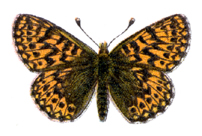
Clossiana (ex Boloria, Argynnis) freija Thunberg, 1791 [Nymphalidae]: a Holarctic northern fritillary with a wingspan of about 35 mm, ranging from Scandinavia across N Russia and Siberia to Japan; it also flies in boreal N America. This is the butterfly Nabokov pursued as a boy on a bog across the Oredezh and as a man in view of Longs Peak, Colorado, both localities merging in his memory and his memoir.
*Gift 133; SpeakM 138; StrOps 324; SelLet 103; NabBut 409 (L)
& Ac: Clossiána/Bolória/Argýnnis fréija • En: Zigzag Fritillary, Freija's Fritillary, (Nabokov) Freya (Fritillary) • Fr: le nacré d l'orcette, (Don) la fritillaire Freya, (Autres rivages) "une petite Bolorie sombre" • Ge: *Freija-Perlmutterfalter • Ru: (Dar) фрея
Clossiana (ex Boloria) frigga Thunberg, 1791 [Nymphalidae]: a Holarctic northern fritillary with a wingspan of c. 38 mm, ranging from Scandinavia through N Russia and Asia and in the American Rocky Mountains from Canada to Colorado.
*StrOps 334; Lep16
& Ac: Clossiána/Bolória frígga • En: Frigga's Fritillary, Willow-bog Fritillary, (Nabokov) Frigga • Fr: le nacré de Thunberg
Clossiana (ex Boloria) frigga sagata Barnes & Benjamin, 1923 [Nymphalidae]: the Sagata Fritillary, in Colorado and SE Wyoming, described from Hall Valley, Colorado.
*StrOps 324
Clossiana (ex Boloria, Argynnis) improba Butler, 1877 [Nymphalidae]: a fritillary from N Fennoscandia, Novaya Zemlya, Arctic Siberia, N America from Labrador to Alaska.
*StrOps 334
& Ac: Clossiána/Bolória impróba • Am: Dingy Arctic Fritillary • En: Dusky-winged Fritillary
Clossiana (ex Boloria) kriemhild Strecker, 1878 [Nymphalidae]: the Relict Meadow Fritillary, in Utah, Wyoming, Idaho and Montana.
*StrOps 324; Lep16
Clossiana (ex Boloria) polaris Boisduval, 1828 [Nymphalidae]: circumpolar in northernmost Europe, Asia and America.
*StrOps 334
& Ac: Clossiána/Bolória poláris • Am: Polar Fritillary
Clossiana selene (Lampert 1907)
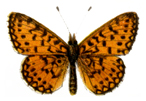
Clossiana (ex Boloria) selene Denis & Schiffermüller, 1775 [Nymphalidae]: a circumpolar tawny-orange fritillary with a wingspan of 30–40 mm, flying in bogs and on moist meadows. The orange-brown hindwings have four rows of metallic silver spots below, one of them (that pearl-necklace of its English name) on the margin. It ranges from the NW of the Iberian peninsula and Great Britain through most of Europe and temperate Asia to Korea and in N America from Alaska to Newfoundland, Oregon, south to New Mexico and North Carolina.
*Gift 133; SpeakM 122; NabBut 398 (L), 448 (L); Lep16
& Ac : Clossiána/Bolória seléne • Am: Silver-bordered Fritillary • En: Small Pearl-bordered Fritillary, (Nabokov) Selene Fritillary • Fr: le petit collier argenté (Don) "des sélènes, petites fritillaries", (Autres ravages) la Fritillaire bordée de Perles • Ge: Braunfleck, Braunscheckiger Perlmutterfalter • Ru: (перламутровка) Селена, обыкновенная перламутровка • Sp: perlada castaña
Clossiana (ex Boloria) selene albequina Holland, 1928 [Nymphalidae]: the Whitehorse Fritillary, described from Whitehorse, Yukon Territory.
*Lep16
Clossiana (ex Boloria) selene tollandensis Barnes & Benjamin, 1925 [Nymphalidae]: the Tolland Fritillary, a subspecies of the Silver-bordered Fritillary described from Tolland, Colorado.
*StrOps 323; NabBut 409 (L), 448 (L); Lep16
Clossiana thore Hübner, 1803 [Nymphalidae]: a fritillary flying in N Scandinavia, in the higher altitudes of the Alps, N of St. Petersburg, on Sakhalin and eastward through Mongolia and Japan.
*StrOps 332
& Ac: Clossiána thóre • En: Thor's Fritillary • Fr: le nacré noirâtre • Ge: Alpen-Perlmutterfalter
Clossiana (ex Boloria) titania Esper, 1793 [Nymphalidae]: a medium sized Holarctic lesser fritillary (wingspan 45 mm) in the Alps, the Balkans, Latvia, Estonia, S Finland E through Siberia to Altai, and in N America.
*StrOps 324, 334
There is a form of doubtful taxonomic status in S Finland and the Baltic states that is very similar to the nominate subspecies Clossiana titania titania, called Clossiana titania rossica Hemming, 1934. In his notes for The Butterflies of Europe, Nabokov reflected that if a name has to be replaced because it turned out to be preoccupied, the new name should be based on the name of the first author, for instance as an anagram of it. As an example he cites Hemming's Clossiana titania rossica. In his opinion, when rossica had to go, the replacement name should have been based on that of titania's author, Eugen »Esper, for instance 'esperi' or 'seripe' (anagram of Esper). However, in reality Clossiana titania rossica turned out to be a junior synonym of Clossiana titania bivina FRUHSTORFER 1908.
*NabBut 579
& Ac: Clossiána/Bolória titánia • En: Titania's Fritillary, (Nabokov) Titania • Fr: le nacré porphyrin • Ge: Natterwurz-Perlmutterfalter • Ru: перламутровка Титания
Clossiana (ex Boloria, Brenthis) titania grandis Barnes & McDunnough, 1916 [Nymphalidae]: the Purple Lesser Fritillary, from New Brunswick to British Columbia.
In the postcript of his last technical paper on butterflies (Lep16, 1950), Nabokov listed all the butterflies he had encountered in Wyoming when looking for Plebejus melissa in the summer of 1949. Among the species listed there is one "B. rossicus grandis (B. & McD.)". The 'B'. either stands for Boloria (the generic name Nabokov had used some lines above) or for Brenthis ( the genus grandis had originally been described in). However, the only Clossiana (sub)species by the name of rossicus or rossica is Hemming's invalid Clossiana titania rossica and neither in the Rocky Mountains nor elsewhere in America. Somebody – Nabokov, the typist, the editor? – must have made a mistake. The mistake appears deliberate as it occurs twice in the same paper; there is also Boloria rossicus ingens. Perhaps somebody had erroneously taken the name rossica – proposed by Francis Hemming for a Baltic and Finnish subspecies of Clossiana titania – as the species name of titania herself. Or was Nabokov jokingly suggesting that titania whose type-locality was Sardinia should really be called "the Russian one"?
*Lep16 76
Clossiana (ex Boloria, Brenthis) titania ingens Barnes & McDunNough, 1918 [Nymphalidae]: the Large Purple Fritillary, in Montana, Idaho and Wyoming. See under »Clossiana titania grandis.
*Lep16 76
Clossiana (ex Boloria) titania helena W.H. Edwards, 1871 [Nymphalidae], the Helena Fritillary, the most abundant of S Rocky Mountains Clossiana species.
*StrOps 324
Clouded Yellow: »Colias crocea
Coenonympha Hübner, 1819: a genus of »Nymphalidae, subfamily Satyrinae, tribe Coenonymphini (US ringlets, GB heaths). The type-species is Coenonympha oedippus Fabricius, 1787, syn geticus Esper, 1793, the False Ringlet, in isolated colonies from W France and C Europe to S Siberia, Korea and Japan.
Coenonympha arcania Linnaeus, 1761 [Nymphalidae, Satyrinae]: a satyrine of Europe, Asia Minor, S Russia, S Urals.
*Lep2 270
& Ac: Coenonýmpha arcánia • En: Pearly Heath • Fr: le céphale • Ge: Perlgrasfalter • Sp: mancha leonada
Coenonympha corinna Hübner, 1804 [Nymphalidae, Satyrinae]: the Corsican Heath, restricted to Corsica, Sardinia and Capri.
*NabBut 595 (BE)
Coenonympha elbana Staudinger, 1901 [Nymphalidae, Satyrinae]: the Elban Heath. According to Tolman & Lewington (1997), the range is Elba, Giglio and the nearby mainland. Nabokov found it listed as a subspecies of Coenonympha corinna and remarked (1964), "The only known butterfly it would seem with a range limited to this small island. The fact of its absence from coastal Italy, if true, is incomprehensible". Since then, it has been found on the Italian mainland.
*NabBut 596 (BE)
Coenonympha glycerion Borkhausen, 1788, hom iphis Denis & Schiffermüller, 1775 [Nymphalidae, Satyrinae]: the Chestnut Heath, in Europe, Russia, N Kazakhstan, Mongolia.
*NabBut 596 (BE)
Coenonympha haydenii W.H. Edwards, 1872 [Nymphalidae, Satyrinae]: Hayden's Ringlet, in the C Rocky Mountains.
*NabBut 595 (BE); Lep16
Coenonympha (ex Chortobius) hero Linnaeus, 1761 [Nymphalidae, Satyrinae]: a "diminutive ringlet" (wingspan 31–33 mm), on moist forest grassland from NE France, C Europe and S Scandinavia across Asia to Mongolia, Amur region, Korea and Japan; vanishing in Europe. "Very abundant with iphis [»Coenonympha glycerion] in the fields of N Russia (e.g. near Leningrad), and ranging eastward to Japan."
*SpeakM 132; StrOps 182: NabBut 595–6 (BE)
& Ac: Coenonýmpha héro • En: Scarce Heath, (Nabokov) Hero • Fr: la mélibée, (Autres rivages) "un minuscule Tristan appelé Moelibée" • Ge: Wald-Wiesenvögelchen • Ru: сенница Геро • Sp: ninfa morena
Coenympha pamphilus (Sepp 1762)
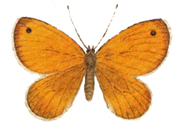
Coenonympha pamphilus Linnaeus, 1758 [Nymphalidae, Satyrinae]: a very common Palearctic satyrine, flying on grassy places up to 1,800 m, in NW Africa, W and C Europe, E to Kazakhstan, the Caucasus, Anatolia, Lebanon, N Irant and between 40 and 60° latitude E to W Mongolia. The wingspan is 28–36 mm, the color is a light ocher tending towards yellow. The ocellae at the forewing tips are vestigial or absent; underneath they have a white center and a yellow ring.
*Lep1 32; Lep2 257, 268
& Ac: Coenonýmpha pámphilus • En: Small Heath • Fr: le procris, le fadet commun • Ge: Kleiner Heu(gras)falter, Kleines (gelbes) Wiesenvögelchen • It: panfilo • Ru: синница Памфил • Sp: ninfa de Linneo
Coenonympha tullia Müller, 1764 [Nymphalidae, Satyrinae]: the Large Heath (Great Britain) or Tullia Ringlet (N America), a Holarctic satyrine (wingspan 35–39 mm) with many local subspecies, from the British islands through N and C Europe and Siberia E to N Sakhalin; also in N America.
*NabBut 595 (BE)
Coenonympha tullia scotica Staudinger, 1901 [Nymphalidae, Satyrinae]: a subspecies of the Large Heath. Nabokov (1964): "Is not isis Thunb[erg] = scotica Staudinger … found in Aberdeenshire, Sutherlandshire etc and in the Orkneys & Shetland Isles? It is the only indigenous butterfly in the Shetlands …" Tolman & Lewington (1997): "Distribution: Scotland, including Hebrides and Orkney islands, north of a line from Glasgow to Aberdeen: transition to tullia in SE Scotland sharply delineated".
*NabBut 595 (BE)
Coenonympha tullia suecica (not suevica) Hemming 1936 [Nymphalidae, Satyrinae]: a subspecies of the Large Heath, in N Europe and N Siberia.
*NabBut 595 (BE)
Colias Fabricius, 1807: a genus of »Pieridae, subfamily Coliadinae (sulphurs), usually of yellow color. The type-species is »Colias hyale, the Pale Clouded Yellow.
The NL name is derived from an Attic goddess, Kōlias. Its gender is feminine, and adjectives serving as species names must agree in gender. Therefore the Clouded Yellow is Colias crocea and not Colias croceus, as many butterfly books maintain.
*StrOps 323, 326; SelLet 368; NabBut 270 (L), 448 (L); LtVé 475
& Ac: Cólias • En: Yellows, Sulfurs • Fr: coliades • Ge: Gelblinge, Kleefalter, Heufalter • Ru: желтушки • Sp: amarillos, colias
Colias aurorina heldreichi Staudinger, 1862 [Pieridae]: a subspecies of the Greek Clouded Yellow, restricted to some mountains in Greece.
*SpeakM 253
& Ac: Cólias aurorína héldreichi • En: Dawn Clouded Yellow, (Nabokov) Heldreich's Sulphur • Ge: *Heldreichs Gelbling
Colias chrysotheme Esper, 1781 [Pieridae]: the Lesser Clouded Yellow, in E Europe, C and E Asia (50–57°N), NE China. What Nabokov cites as the subspecies "schugurowi Krulikovski" might be schugorowi Verity, 1909 and is regarded as a synonym of the nominal subspecies Colias chrysotheme chrysotheme, described from Hungary.
*NabBut 587 (BE)
Colias caucasica Staudinger, 1871, syn olga Romanoff, 1882 [Pieridae]: the Balkan Clouded Yellow, 'Romanoff's olga' (романовская ольга) of "Father's Butterflies", orange with brown margins, wingspan 48–56 mm, in isolated colonies in S Balkans and Greece, NE Turkey and W Caucasus, "so fleet-winged that no dzhigit [crack Caucasian horseman] could keep up with it".
*NabBut 206 (FB)
Colias crocea (Procházka 1963)
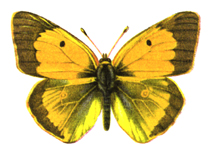
Colias crocea Geoffroy in Fourcroy, 1785 [Pieridae]: a strongly migratory yellow butterfly of N Africa, S and C Europe and W Asia. It appears in some years and then stays away for a period. The first generation migrates to C Europe from the Mediterranean in late April and May; the second generation breeds there and flies from June to August; occasionally there is a third generation in October. The Clouded Yellow is a strong and swift flyer.
What was just "a golden-orange butterfly" in "First Love" was explicitly identified as a Clouded Yellow in Speak, Memory.
*Stor:1stLove 604; SpeakM 147; Ada 524; Lep1 31; Lep2 257, 268
& Ac: Cólias crócëa • En: Clouded Yellow • Fr: le souci • Ge: Wandergelbling, Postillon, Großes Posthörnchen • It: croceo • Ru: желтушка шафрановая • Sp: colias común, amarilla
Colias crocea var. vernalis Verity, 1902, syn (of vernalis) f. minor Failla 1889 [Pieridae]: the spring generation of »Colias crocea, the Clouded Yellow.
*Lep2 256
Colias edusa Fabricius, 1787 [Pieridae]: an obsolete name of »Colias crocea, the Clouded Yellow. See also »Edusa Gold. Not to be confused with another pierid, »Pontia edusa Fabricius, 1777, the Eastern Bath White.
Colias eurytheme Boisduval, 1852 [Pieridae]: the Alfalfa Butterfly, in N America, from the Hudsonian Zone to S Mexico.
*NabBut 398 (L)
Colias hecla Lefèbvre, 1836 [Pieridae]: a yellow circumpolar pierid, from Scandinavia to Greenland. The variety pallida Skinner, 1892 has been synonymized under hecla.
*StrOps 325
& Ac: Cólias hécla • Am: Arctic Orange • En: Northern Clouded Yellow
Colias hyale Linnaeus, 1758 [Pieridae]: a Sulphur in C Europe, NW and C Asia, NE China. The wingspan is 46–49 mm, the males are yellow, the females white, both with broad dark shading in the corners of the upper forewings and orange spots on the upper hindwings.
*Lep1 31; Lep2 257, 268
& Ac: Cólias hýale • En: Pale Clouded Yellow • Fr: le soufré • Ge: Goldene Acht, Gemeiner Heufalter • Ru: луговая желтушка, желтушка Гиала • Sp: colias pálida
Colias interior Scudder, 1862 [Pieridae]: a N American Sulphur, yellow with rich pink fringes, from British Columbia to Nova Scotia and across the Great Lakes to Virginia.
*SpeakM 138; SelLet 41
& Ac: Cólias interiór • Am: Pink-edged Sulphur • Fr: (Autres rivages) la Coliade à franges roses • Ge: *Interior-Gelbling
Colias meadi W.H. Edwards, 1871 [Pieridae]: the Alpine Orange. Three specimens of this Sulphur collected by Nabokov in Wyoming and New Mexico are pictured in the Achievements of Vladimir Nabokov (Cornell 1984), p. 247.
*StrOps 324–325
Colias occidentalis Scudder, 1862 [Pieridae]: the Western Sulphur, from British Columbia to C California, Arizona and New Mexico.
*SelLet 103
Colias palaeno Linnaeus, 1761 [Pieridae]: a very pale yellow Holarctic Sulphur (wingspan 40–50 mm) of C, E and NE Europe, W and C Asia (50–70°N), Siberia, Sakhalin, Mongolia, NE China, Korea, Japan and N America (Alaska to Baffin Island, south to Alberta and Manitoba). It is a denizen of acidic marshes and bogs with Vaccinium (blueberries).
*NabBut 465 (L)
& Ac: Cólias paláeno • Am: Palaeno Sulphur • En: Moorland Clouded Yellow • Fr: le solitaire • Ge: Moorgelbling, Zitronengelber Heufalter • Ru: торфяниковая желтушка, желтянка • Sp: colias de los pantanos
Colias pelidne Boisduval & Lecomte, 1828 [Pieridae]: the Pelidne Sulphur, on Baffin Island, in Labrador and Newfoundland.
*NabBut 465 (L)
Colias pelidne skinneri Barnes, 1897 [Pieridae]: Skinner's Sulphur, a subspecies of the Pelidne Sulphur, in Canada, Montana, Idaho and Wyoming.
*StrOps 324; NabBut 465 (L); Lep16
Colias sareptensis Staudinger, 1871, syn australis Verity, 1911 [Pieridae]: Berger's Clouded Yellow, in C and S Europe, S Russia. Asia Minor, Caucasus, Transcaucasia. C Asia, China.
*NabBut 587 (BE)
Colias philodice Godart, 1819 [Pieridae]: the Clouded Sulphur, in Alaska, Yukon Territory and the adjacent parts of British Columbia and the Northwest Territories.
*NabBut 398 (L)
Colias scudderi Reakirt, 1865 [Pieridae]: Scudder's (Willow) Sulphur, mainly on meadows in the Colorado massif. Nabokov suggested it should be classified as Colias palaeno scudderi which has not happened. In July–August 1952, in Wyoming, he was looking for an intermediate form between Colias scudderi and »Colias pelidne skinneri, but did not find it.
*StrOps 324
Colias skinneri: »Colias pelidne skinneri
Colias verae Nabokov: "Véra's Colias," an imaginary butterfly Nabokov drew for his wife on October 1, 1965. It looks very much like »Colias crocea, the Clouded Yellow, only it is blue instead of yellow.
*Véra's Butterflies, p. 23
Colostygia (ex Larentia) turbata pyrenaearia Oberthür, 1884 [Geometridae, Larentiinae]: Nabokov found this insect in the Pyrenees and called it "delightful".
*Lep2 270
Comma Butterfly: »Polygonia c-album, »anglewing. Not to be confused with »Hesperia comma, the Silver-spotted Skipper.
*Stor:MlleO 482; SpeakM 106
Common Blue: »Polyommatus icarus
copper: the members of the subfamily »Lycaeninae of »Lycaenidae. In many of its species at least the males are colored a lustrous golden copper. The problem with the vernacular term is the same as with »blue – color and taxa do not always coincide.
*Stor:Xmas 134
& En: Copper • Fr: cuivrés, (Don) le Lycène cuivré • Ge: Feuerfalter • Ru: червонцы, настоящие голубянки
coppers, violet-tinged: »Palaeochrysophanus hippothoe
Cordigera: »Anarta cordigera
Corsican Swallowtail: »Papilio hospiton
Cosmolyce boeticus: »Lampides boeticus
Cossidae Leach, 1815: a small family of plump moths, totaling 500 to 800 species all over the world, least in N America. They are medium-sized to very large and generally fly by night. Their coloring makes them merge with cracky bark. Their caterpillars bore holes through the bark of trees. The name derives from the Latin word cossus, the worm that lives in wood.
& Ac: Cóssidae • Am: carpenter worm moths • En: goat moths • Fr: cossidés • Ge: Cossiden, Holzbohrer • It: cossidi • Ru: древоточцы • Sp: cósidos
|
Cossus cossus and its caterpillar (Lampert 1907) |
|
|
|
|
Cossus cossus Linnaeus, 1758 [Cossidae], syn ligniperda Fabricius, 1794: a large night-flying moth with a wingspan of 65–80 mm and a stout body. It has a strong goatish scent (therefore its name). Its caterpillar bores into the wood of tree-trunks where it lives for two years (mostly willows, poplars and apple-trees). The range is N Africa, Europe, temperate Asia.
*SpeakM 132
& Ac: Cóssus cóssus • En: Goat Moth • Fr: le cossus gâte-bois, (Autres rivages) le Gâte-Bois • Ge: Weidenbohrer, Weidenspinner • It: cosso, perdilegno rosso • Ru: древоточец обыкновенный, пахучий древоточец • Sp: taladro
Cowl, also 'Shark': »Shargacucullia verbasci
Craniophora (ex Acronicta) pontica Staudinger, 1879 [Noctuidae, Acronictinae]: a European owlet moth, N and E of the Black Sea.
*Lep1 33
Crestos lovitza SIRIN: an imaginary butterfly Nabokov drew in one of his letters to Véra (9 June 1926) in order to accomodate a little Russian crossword puzzle (krestoslovitsa) he had made up for her. The outlines which he had obviously traced from some butterfly album are those of a Lesser Purple Emperor (Apatura ilia) or possibly a Poplar Admiral (Limenitis populi).
*LTVé 124
Cupidinae = Blues: a proposed and abandoned subfamily of »Lycaenidae that Nabokov obviously intended to use in "The Butterflies of Europe", constructed around the genus »Cupido. "A somewhat loose aggregation (serviceable mainly for the Holarctic fauna) corresponding to the popular notion of 'Blues', 'Coeruleae', Germ. Bläulinge, Fr. Azures, Russ. Golubyanki, etc. It also corresponds to the old group Lycaena …, to the [tribe] Polyommatini of »Forster (1938) {check} and to the »Plebejinae of authors e.g. of »Verity, 1943 (but not of »Stempffer or Nabokov). It could have been made to comprise the Lycaeninae ('Coppers') had it not been important to stress certain distinctions between the two groups such as the structural gap separating blue Lycaena [»Chalceria] heteronea Boisduval of N. America from genuine 'Blues'."
*NabBut 605 (BE)
Cupido Schrank, 1801: a genus of small »Lycaenidae, subfamily Polyommatinae (blues), tribe Polyommatini, Everes Section. The type-species is »Cupido minimus, the Little Blue.
*NabBut 575 (BE)
Cupido carswelli (Tolman & Lewington, 1997)

Cupido carswelli STEMPFFER, 1927 [Lycaenidae]: one of the smallest European butterflies, with a wingspan of c. 20 mm. Both in males and females, the basic color is dark brown. It flies locally between 1,000 and 1,800 m in the mountains of S and SE Spain.
There is a puzzling remark concerning this butterfly in one of Nabokov's Letters to Véra (3 June 1939) which Brian Boyd has marvelously resolved in his notes to the book. The remark was: "... Stempfer, who lives in Paris (and with whom Riley, in 1929, had a famous run-in over carswelli-arcilani – you remember) ..."
Boyd explained this remark thus: "In 1926 the amateur lepidopterist Morris Carswell (1862–1942), after catching a butterfly in Murcia new to him, passed it on to Stempffer, who identified it as a new sub-species, which he named in Carswell’s honour, 'Cupido minimus carswelli TTTS', Soc Boll. FRCS. Ent. (1927), p. 247. The same year, Riley [in London] named it as a new species, Cupido arcilasis RILEY, from specimens in the same locality collected by Carswell’s friend Cooke: 'A New European Lycaenid: Cupido arcilacis', Entomologist, 60 (1927), pp. 269–76. The next year, Stempffer, after a detailed morphological examination of the butterfly and its congeners, concluded it was a new species [i.e., not a mere sub-species], in 'Contribution a l'étude de Cupido carswelli STEMPFFER', Encycl. Ent. Ser. B. III Lep., 3 (1928), pp. 105–15. Riley responded in 'Cupido carswelli STEMPFFER = Cupido arcilacis RILEY', Entomologist, 61, pp. 38, 91, but his species name was ultimately invalidated. The specific status of Cupido carswelli, often in dispute, was eventually resolved in Felipe Gil-T., 'Cupido carswelli (STEMPFFER, 1927): morphology of its chrysalis and genitalia compared with those of Cupido minimus (FUESSLY, 1775) and Cupido lorquinii (HERRICH-SCHÄFFER, 1847) (Lepidoptera, Lycaenidae)', Atalanta, 37 (1/2) (September 2006), pp. 150–60."
& En: Carswell's Little Blue • Fr: l'azuré murcian • Ge: *Carswells Zwergbläuling • Sp: la duende murciano
*LtVé 423
Cupido minimus, male (Lampert 1907)

Cupido (ex Zizera) minimus Fuessly, 1775 [Lycaenidae]: along with »Chilades trochylus one of the smallest butterflies, with a wingspan of about 20 mm, in N Spain, most of Europe, east to Mongolia and Amur region. Males and females are brown.
*Lep2 269
& Ac: Cúpido/Zízera mínimus • En: Osiris Blue, Little Blue • Fr: l'argus minime • Ge: Zwergbläuling • Ru: голубянка Минима, карликовая голубянка • Sp: duende oscuro
Cyaniris Dalman, 1816: an abandoned genus of »Lycaenidae, subfamily Polyommatinae (blues). The type-species was Cyaniris argianus Dalman, 1816 which is considered a synonym of »Polyommatus semiargus Rottemburg, 1775. In consequence of Bálint & Johnson's reformation of the »Polyommatus Section in 1997, Cyaniris was included in Polyommatus Latreille 1804.
Cyaniris semiargus: »Polyommatus semiargus
Cyclargus Nabokov, 1945: a new genus of S American blues established by Nabokov by splitting it off the genus Hemiargus. Some authors have not followed him in splitting Hemiargus, so sometimes all Cyclargus butterflies are still found under Hemiargus. However, Cyclargus has proved a valid genus (»Section 1.1).
*Lep9 14–20, 47, passim
Cyclargus ammon Lucas, 1857 [Lycaenidae]: Lucas's Blue, in Cuba.
*Lep9 17 passim; Lep13 279
Cyclargus dominica Möschler, 1886 [Lycaenidae]: the Jamaican Blue, on Jamaica.
*Lep9 16–17 passim; Lep13 279
Cyclargus erembis Nabokov, 1948 [Lycaenidae]: a Neotropical blue from the Cayman Islands of which Nabokov examined a specimen preserved in the Oxford University Museum and found it to belong in his new genus »Cyclargus where it received the name erembis Nabokov, 1948 (see in »Section 1.1). He predicted that this butterfly will also be found in Cuba. In his paper on the new species (Lep13), Nabokov mentioned that A.S. Corbet in 1943 had wrongly applied the name Hemiargus catilina Bethune-Baker nec Fabricius to this butterfly and to similar material in the Natural History Museum, London.
*Lep13 . N/WLet #144=114old; Lep13
Cyclargus thomasi Clench, 1941 [Lycaenidae]: Thomas's Blue or Caribbean Blue, in Florida, the Bahamas, Puerto Rico and Hispaniola.
*Lep9 18–20, passim; Lep13 passim
Cyclargus thomasi bethunebakeri Comstock & Huntington, 1943 [Lycaenidae]: the Miami Blue, in S Florida and the Florida Keys.
*Lep13 279
Cyclargus thomasi noeli Comstock & Huntington, 1943 [Lycaenidae]: a blue in the British Museum, probably from Hispaniola.
*Lep13 273
Cyclargus woodruffi Comstock & Huntington, 1943 [Lycaenidae]: a blue on the Virgin Islands (Nevis Island).
*Lep9 17–18 passim; Lep13 passim
Cyllopsis R. Felder, 1869: an American genus of »Nymphalidae, subfamily Satyrinae, tribe Euptychiini (US wood satyrs). The type-species is Cyllopsis hedemanni R. Felder, 1869, a wood satyr in Mexico and Panama.
Cyllopsis (ex Neonympha) henshawi W.H. Edwards, 1876 [Nymphalidae, Satyrinae], Henshaw's Brown: see »Cyllopsis pertepida dorothea, Section 1.1.
*NabBut 497 (L); Lep5
Cyllopsis (ex Neonympha, Euptychia) pertepida Dyar, 1912 [Nymphalidae, Satyrinae]: the Warm Brown, a satyr with a wingspan of 38 to 44 mm, reddish-brown above; the undersides have brown lines crossing. It flies in arid country on low mountains from Colorado through Arizona and New Mexico to Mexico.
Cyllopsis (ex Neonympha) pertepida avicula Nabokov, 1942 [Nymphalidae, Satyrinae]: the Texas Brown. See in »Section 1.1.
Cyllopsis pertepida dorothea (Howe 1975)
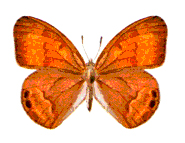
Cyllopsis (ex Neonympha) pertepida dorothea Nabokov, 1942 [Nymphalidae, Satyrinae]: the Canyonland Satyr (or Dorothy's Satyr), also known as 'Nabokov's Wood Nymph'. See in »Section 1.1.
*SelLet 114, 239; NabBut 247 (L), 248 (L), 497 (L), 521 (L); Lep5
Cyllopsis (ex Neonympha) pertepida maniola Nabokov, 1942 [Nymphalidae, Satyrinae]: see in »Section 1.1.
*NabBut 385 (L), 497 (L)
Cyllopsis (ex Euptychia) pyracmon Butler, 1866 [Nymphalidae, Satyrinae]: the Pyracmon Brown or »Nabokov's Satyr (R.M. Pyle in remembrance of Nabokov's work on NW American satyrs). This is a satyr with a wingspan of 38–44 mm, dull brown above; the undersides have faint brown lines crossing. It flies on sunny openings in arid woodland from Arizona and New Mexico through Mexico to Guatemala.
*NabBut 248 (L)
Cyllopsis pyracmon nabokovi Miller, 1974 [Nymphalidae, Satyrinae]: Nabokov's Satyr or Nabokov's Brown. See in »Section 1.2.
Cynthia Vane: Brian Boyd was the first to suggest that there may be a cryptic butterfly hidden in the name of the older of the sisters in Nabokov's last published story The Vane Sisters (1959, written in 1951).
Cynthia is a generic name introduced by Johann Christian »Fabricius in 1807. As type-species he designated »Cynthia cardui Linnaeus, 1758, the Painted Lady [Nymphalidae, Nymphalinae]. The next genus in his book (Systema Glossatorum) that was never properly published was to be Vanessa, with the Red Admiral (»Vanessa atalanta Linnaeus, 1758) as its type-species. Later, entomologists tended to consider the genera represented by cardui and atalanta as one and the same. This made their generic names synonyms of each other. How was the united genus to be called? Cynthia or Vanessa? Both names were made known in the same year, so none had any clear chronological precedence. But there was also the so-called Principle of Page and Line Precedence. As Cynthia was to have appeared a few pages before Vanessa in the same book, it could have been accorded precedence. To save Vanessa, there was an appeal to the International Commission on Zoological Nomenclature in 1934 not to apply the Principle of Page Precedence but the First Reviser Principle. It stipulates that the name the first reviser of the genera involved considered valid should have precedence. In 1944, the Commission complied and thus rescued Vanessa (Opinion 154). Nabokov thought they had done so for "sentimental reasons" and should have given precedence to Cynthia. Cynthia, however, did not become altogether defunct. In 1954, the Commission, completing the case, ruled that the name Cynthia may be used "by any specialist who may consider the type-species of this genus as generically distinct from [atalanta]". That is, while it definitely is Vanessa atalanta, it may be Vanessa cardui or Cynthia cardui depending on the viewpoint of the author.
Nabokov's 'Cynthia Vane' combines both generic names, mangling the second one and thus expressing his preference.
It is not imperative to look for a cryptic butterfly in the younger Vane sister's name, Sybil. If one absolutely wants to find one, there is an obliging Chilean blue by the name Pseudolucia sybilla Kirby, 1871 [Lycaenidae, Polyommatinae, Polyommatini, Polyommatus Section], and there is an obsolete synonym of what today is Ladoga camilla Linnaeus, 1764, the White Admiral: Papilio sibilla Linnaeus, 1769 [Nymphalidae, Limenitidinae].
